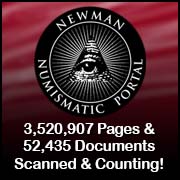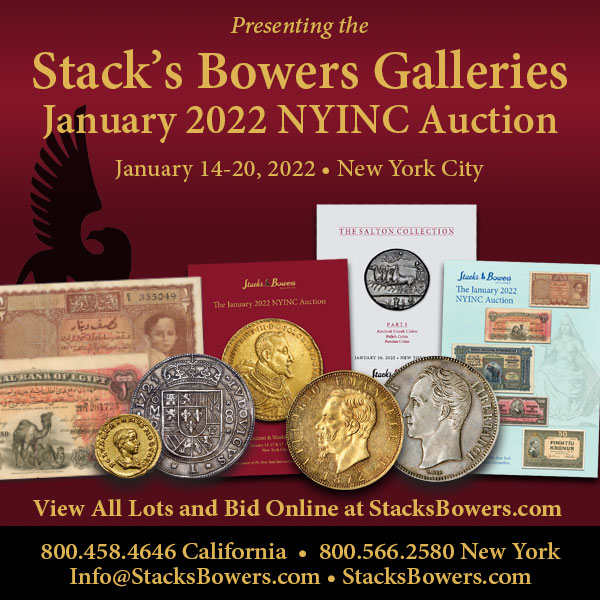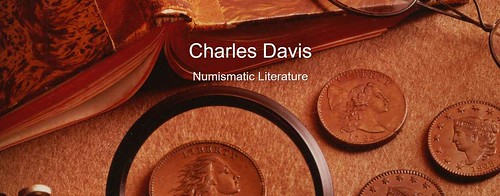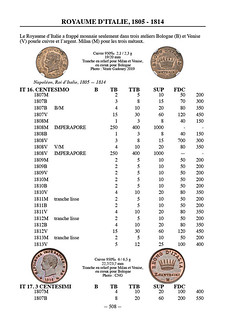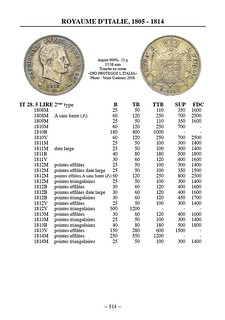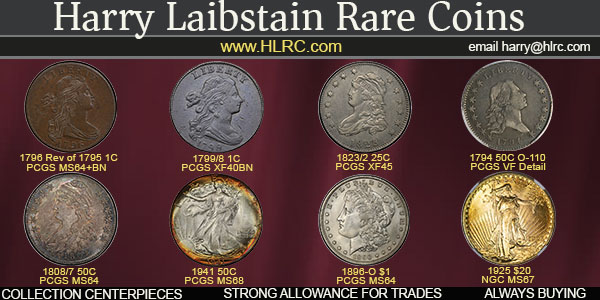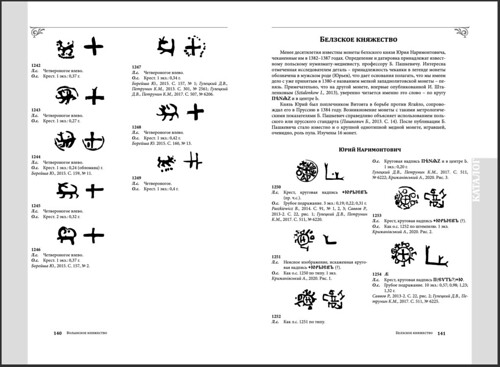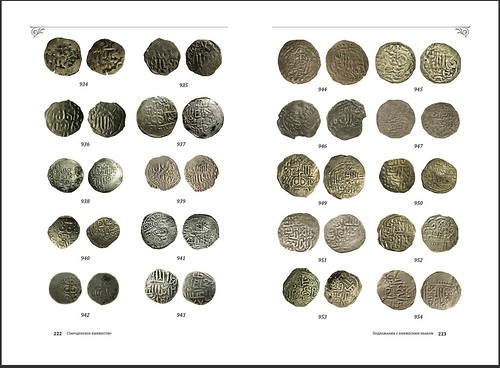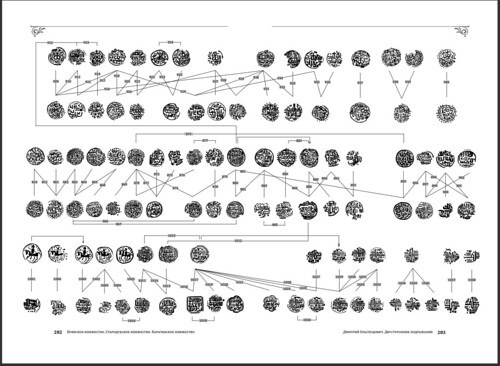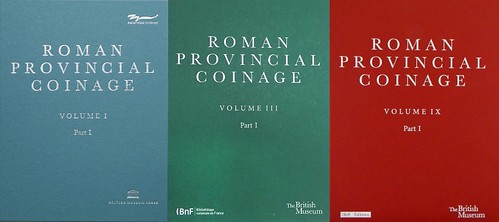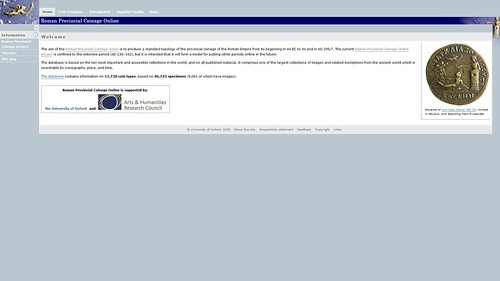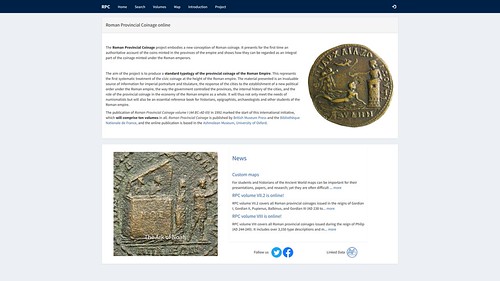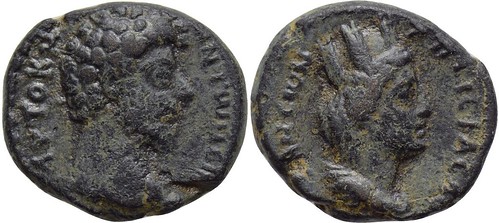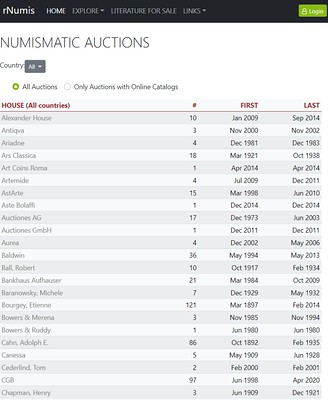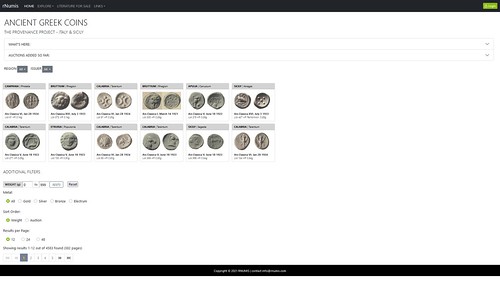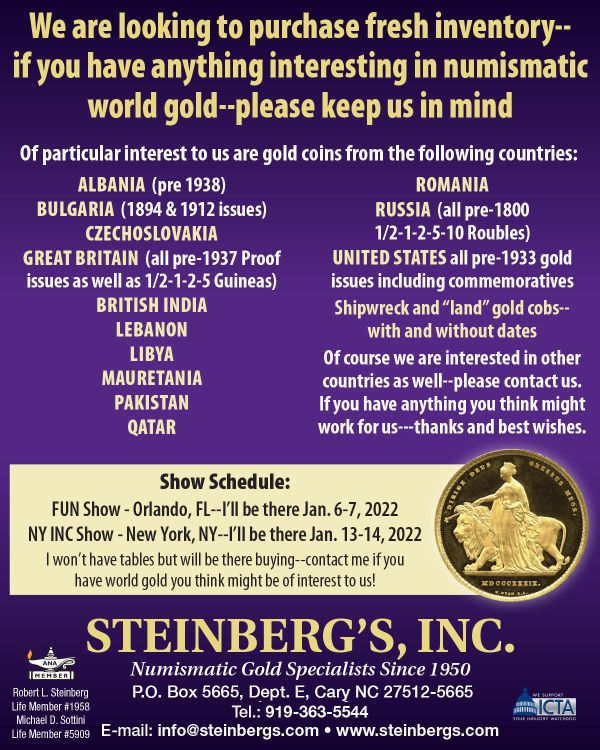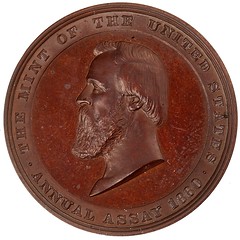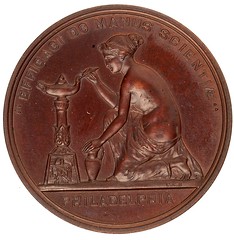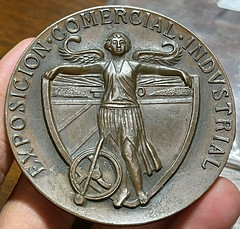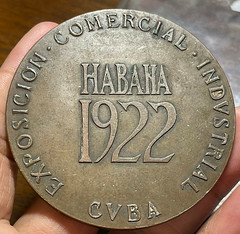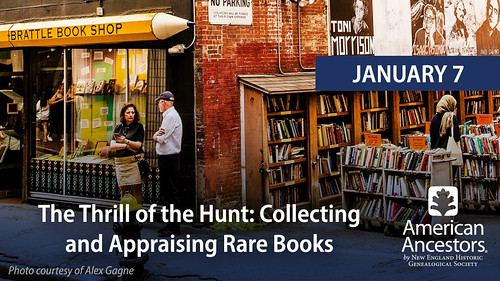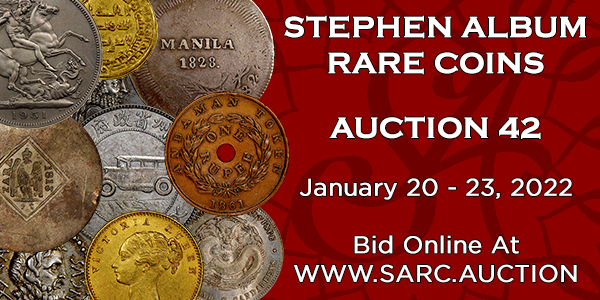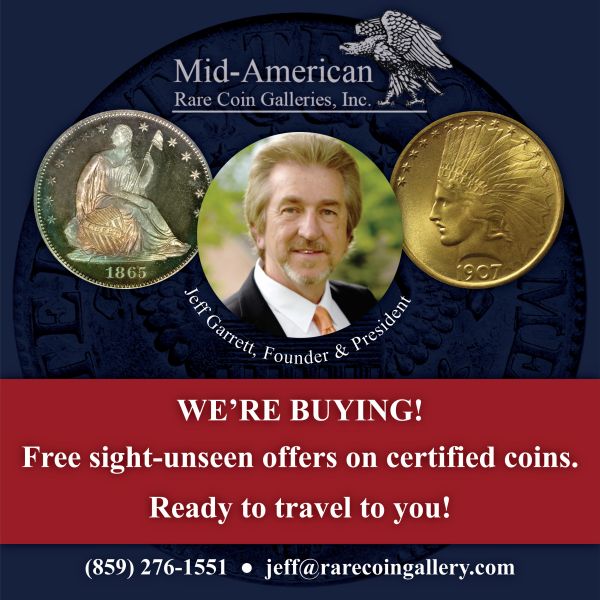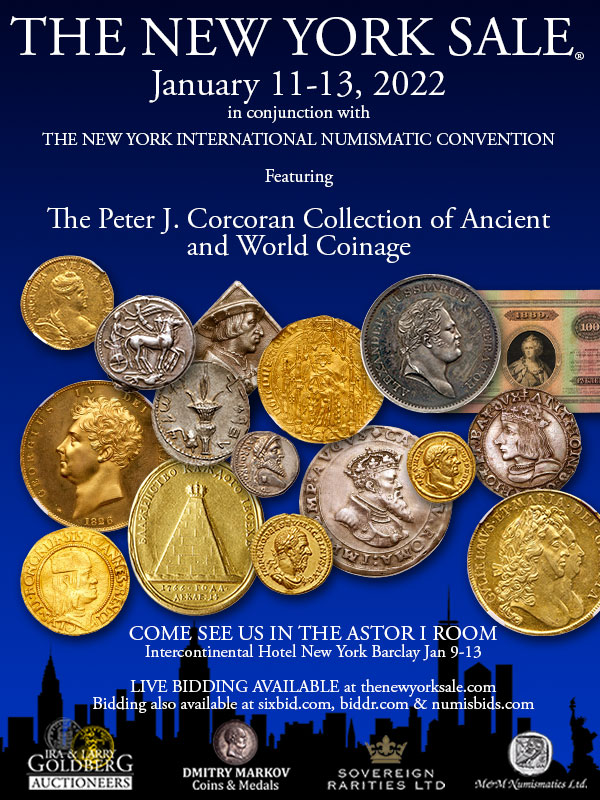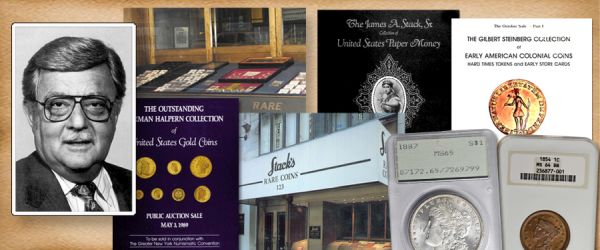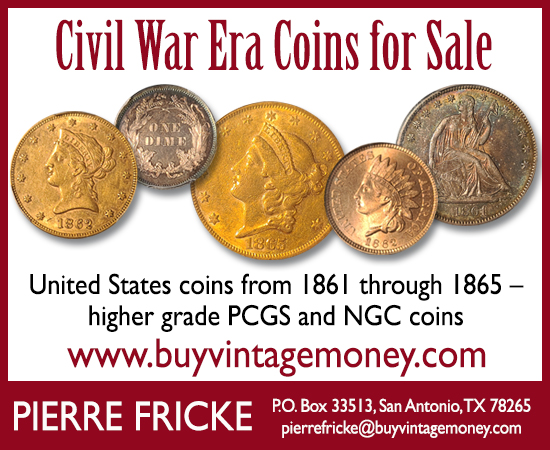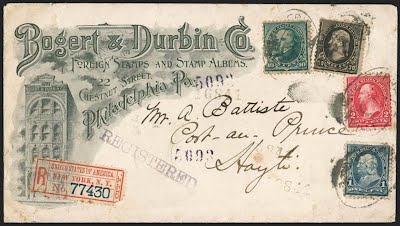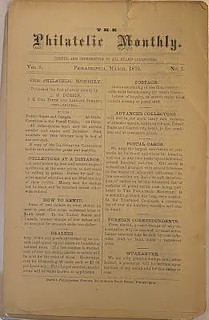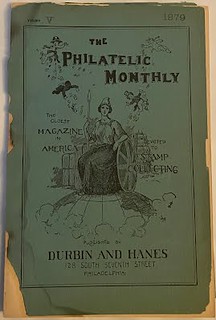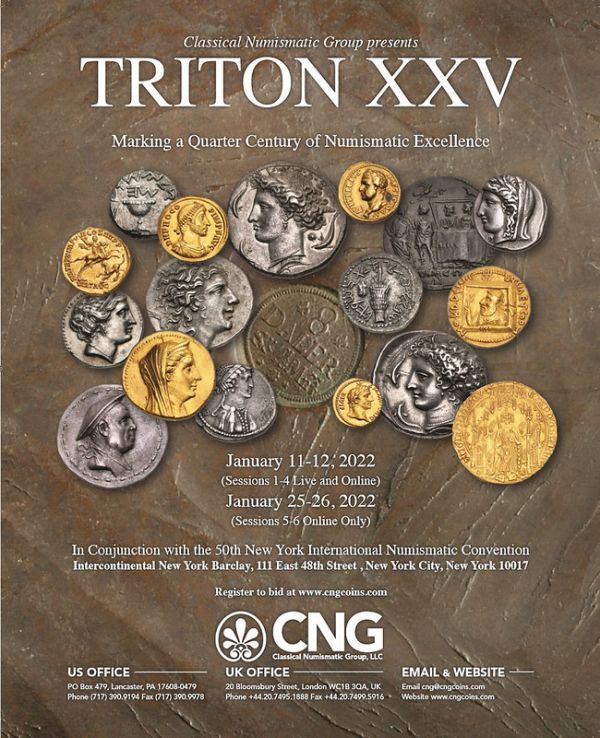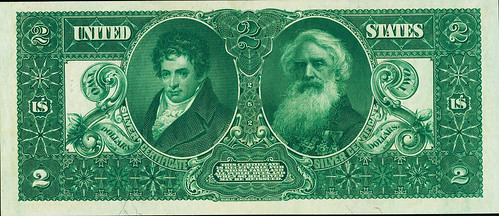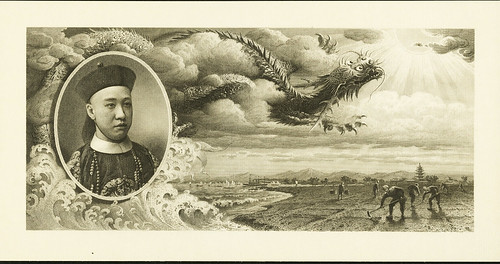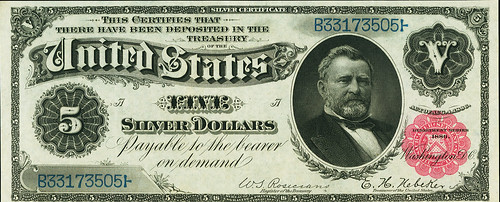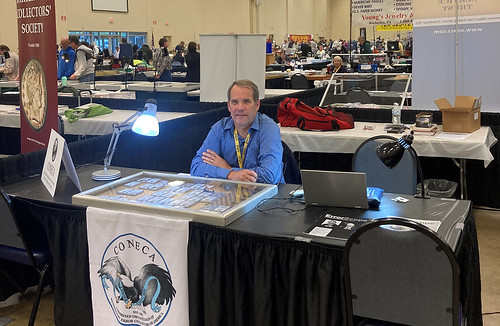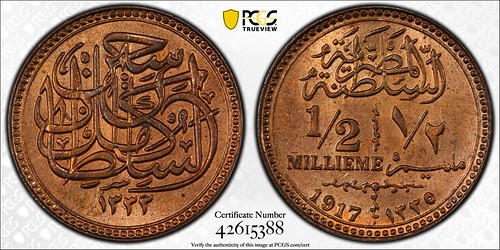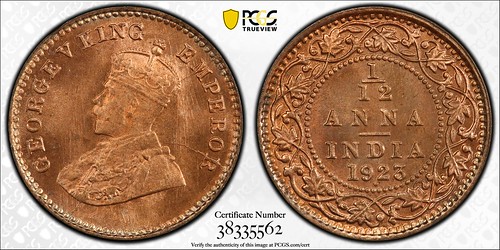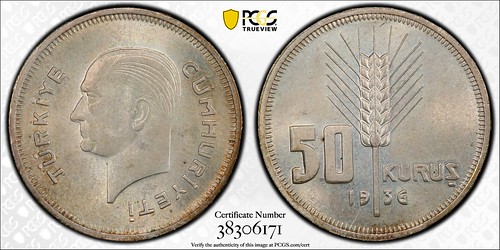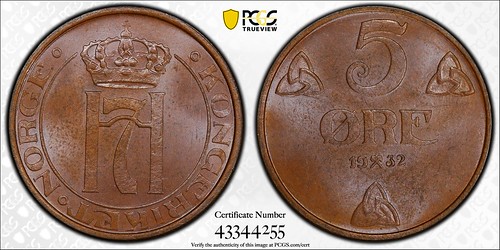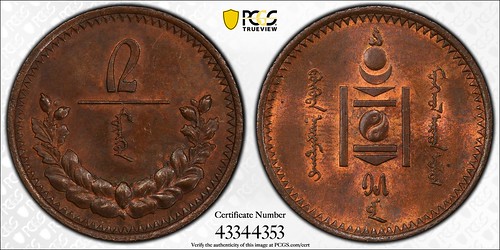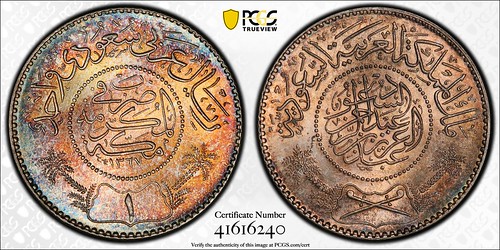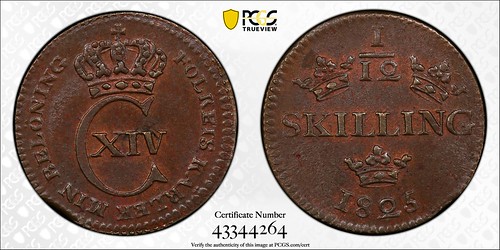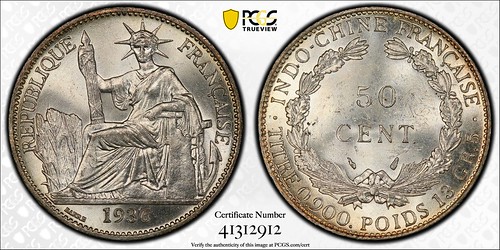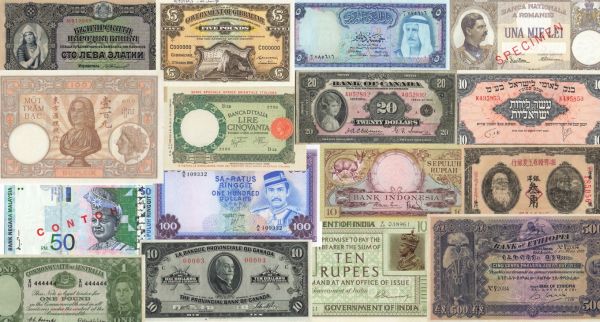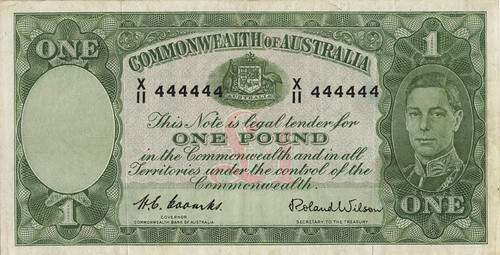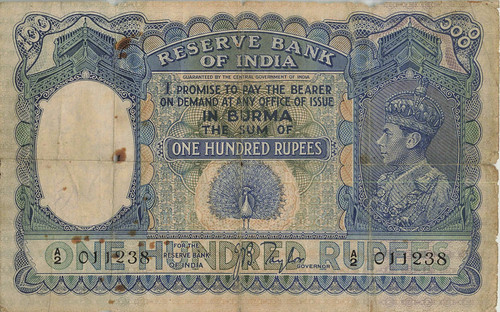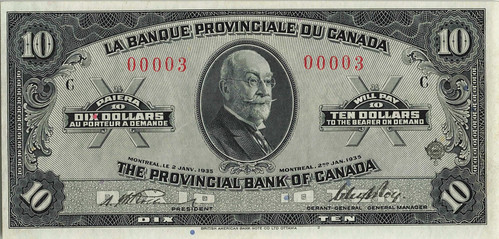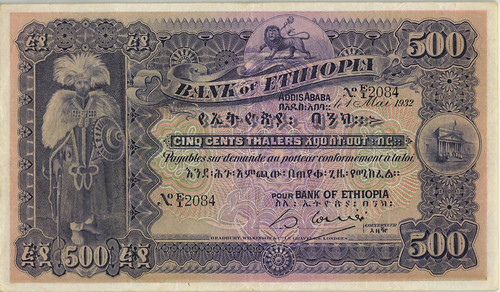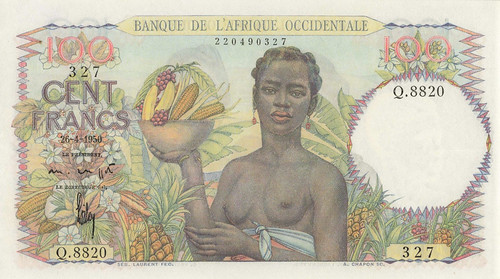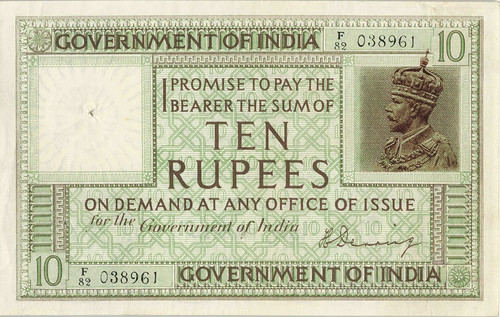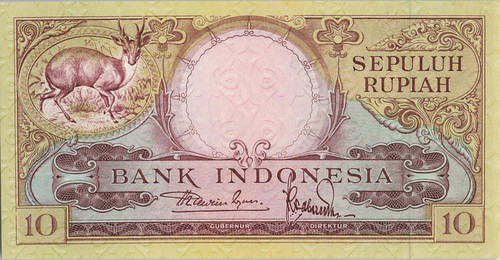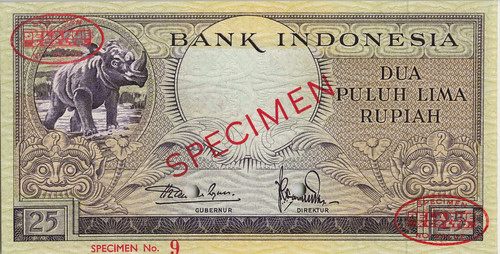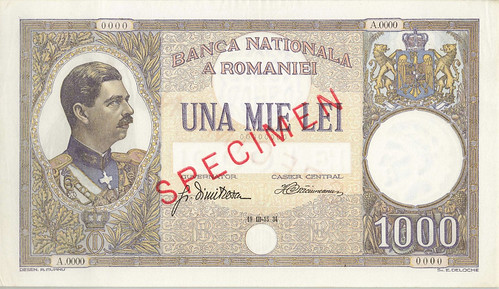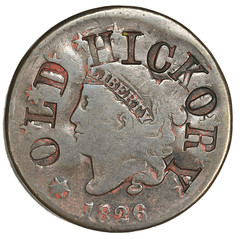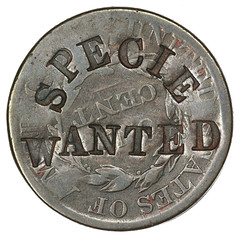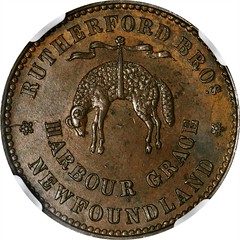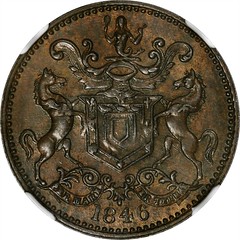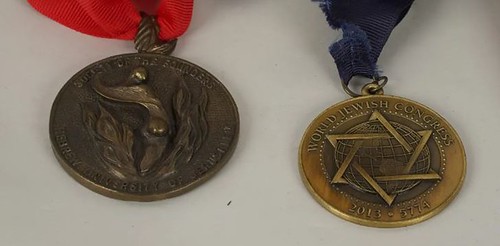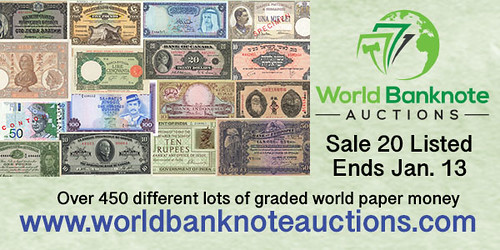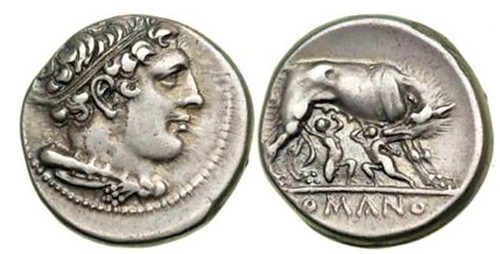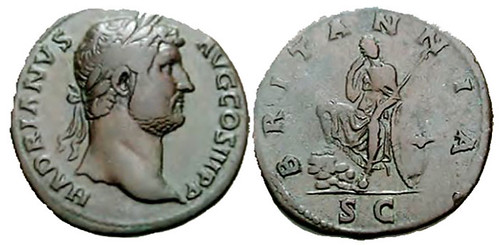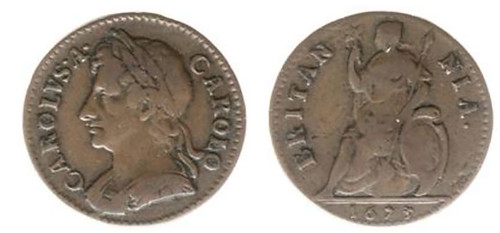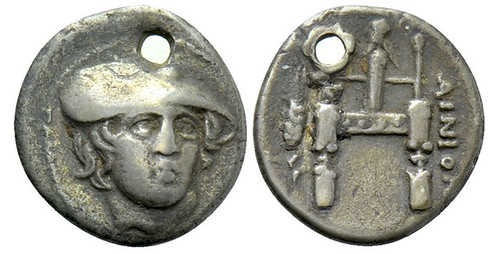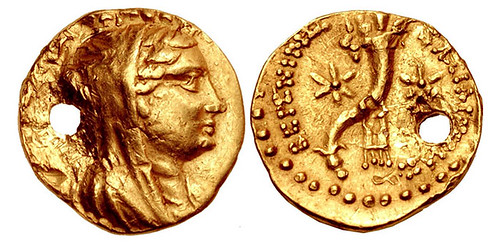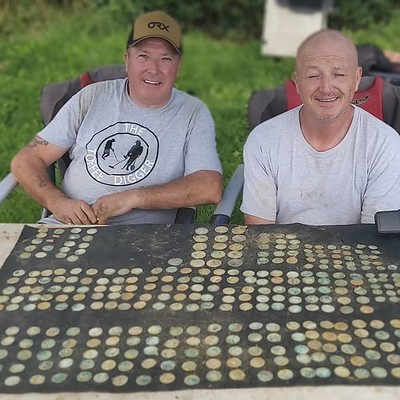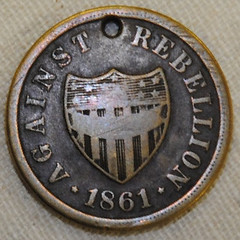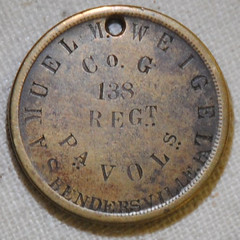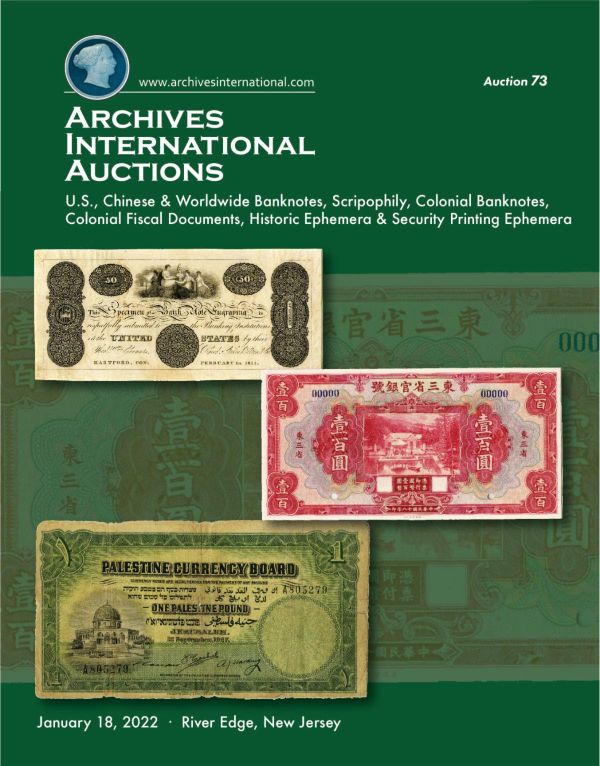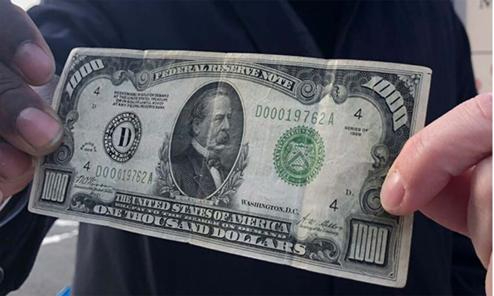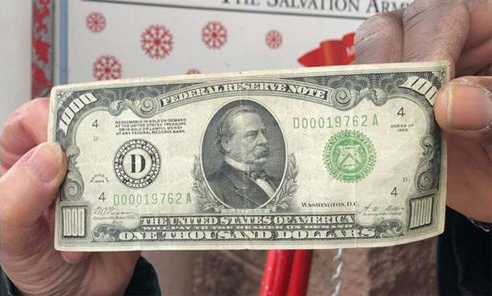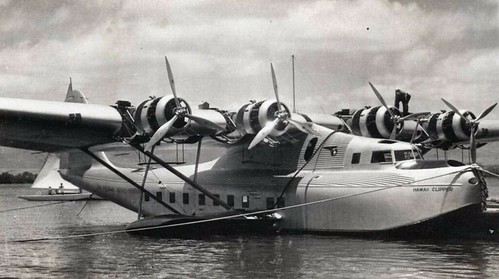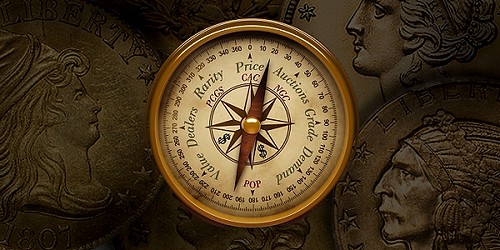
Visit our NBS Sponsors



About UsThe Numismatic Bibliomania Society is a non-profit association devoted to the study and enjoyment of numismatic literature. For more information please see our web site at coinbooks.org SubscriptionsThose wishing to become new E-Sylum subscribers (or wishing to Unsubscribe) can go to the following web page link MembershipThere is a membership application available on the web site Membership Application To join, print the application and return it with your check to the address printed on the application. Print/Digital membership is $40 to addresses in the U.S., and $60 elsewhere. A digital-only membership is available for $25. For those without web access, write to: Charles Heck, Treasurer AsylumFor Asylum mailing address changes and other membership questions, contact Chuck at this email address: treasurer@coinbooks.org SubmissionsTo submit items for publication in The E-Sylum, write to the Editor at this address: whomren@gmail.com BUY THE BOOK BEFORE THE COINSale CalendarWatch here for updates! |
- WAYNE'S WORDS: THE E-SYLUM JANUARY 2, 2022
- CHARLES DAVIS NOT ATTENDING NYINC 2022
- NEW BOOK: MONNAIES FRANçAISES, 1789-2021
- NEW BOOK: RUTHENIAN COINAGE OF LITHUANIA
- NEW BOOK: SELEUCID COINS IN CENTRAL ASIA
- NEW BOOK: GERMAN TOKEN CATALOGUE 2022
- LIBRARY OF COINS ALBUMS VALUE GUIDE UPDATED
- GOLD DOLLAR SALOON OPEN ON NEW YEAR'S DAY
- VIDEO: 2022 FUN SHOW COMMERCIAL
- MORE WEBSITES FOR RESEARCHING ANCIENTS
- ON BRONZED COPPER
- LOAN OFFICE CERTIFICATES
- NOTES FROM E-SYLUM READERS: JANUARY 2, 2022
- MORE ON THE FUTURE OF LIVE AUCTIONS
- VOCABULARY TERM: RELIEF
- ROBERT FRIEDBERG (1912-1963)
- HARVEY STACK'S NUMISMATIC FAMILY, PART 112
- STAMP DEALERS BOGERT & DURBIN
- ENGRAVER LORENZO HATCH
- CONECA AT THE FALL 2021 PAN SHOW
- STEPHEN ALBUM INTERNET AUCTION 13 RESULTS
- WORLD BANKNOTE AUCTIONS SALE 20
- NUMISMATIC NUGGETS: JANUARY 2, 2022
- THE INFLUENCE OF ANCIENT COIN DESIGNS
- ANCIENT COINS THAT WERE PIERCED
- BIGGEST EVER HOARD OF FORGED COINS FOUND
- BATTLEFIELD ACQUIRES SOLDIER DOG TAG
- EURO BANKNOTE REDESIGN COULD REVIVE RIVALRIES
- SALVATION ARMY'S $1,000 BILL MYSTERY
- LOST CLIPPER GOLD-BACKED BANKNOTES THEORY
- LOOSE CHANGE: JANUARY 2, 2022
Click here to read the thin version on the web
Click here to subscribe
Click here to access the complete archive
To comment or submit articles, reply to whomren@gmail.com
Content presented in The E-Sylum is not necessarily researched or independently fact-checked, and views expressed do not necessarily represent those of the Numismatic Bibliomania Society.
WAYNE'S WORDS: THE E-SYLUM JANUARY 2, 2022
 New subscribers this week include:
Bill Corbin.
Welcome aboard! We now have 6,748 subscribers.
New subscribers this week include:
Bill Corbin.
Welcome aboard! We now have 6,748 subscribers.
Thank you for reading The E-Sylum. If you enjoy it, please send me the email addresses of friends you think may enjoy it as well and I'll send them a subscription. Contact me at whomren@gmail.com anytime regarding your subscription, or questions, comments or suggestions about our content.
This week we open with an update from literature dealer Charlie Davis, four new books, updates from the Newman Numismatic Portal, reader comments, Loan Office Certificates, and more.
Other topics this week include bronzed copper, the future of live auctions, Robert Friedberg, Lorenzo Hatch, auction previews and results, ancient coin designs and their influence, a Civil War soldier dog tag, Euro banknote redesign, and the Salvation Army's $1,000 bill mystery.
To learn more about the Rouge Book, Lithuanian numismatics, German tokens, Library of Coins Albums, the Gold Dollar Saloon, websites for researching ancient coins, the 1922 Havana Exposition, the Floyd T. Starr collection, the Banque Provinciale du Canada, Don Rickles' medals, coelanaglyptic relief and the Matrix, read on. Have a great week, everyone!
Wayne Homren
Editor, The E-Sylum
CHARLES DAVIS NOT ATTENDING NYINC 2022
Numismatic literature dealer Charles Davis writes:
"It is with regret that I have canceled my booth at the New York International scheduled for mid-January. The primary purpose of my setting up at that show has been to renew friendships and acquaintances with clients and colleagues from Europe and Asia. Several of those have already told me that they will not travel based on the possibility of having to quarantine in the States should they test positive while attempting to return home. Unfortunate - as we have recently purchased the ancient and foreign library of Spink and looked forward to offering the better titles in New York. At this point we have no intention of writing a catalogue but will add lots periodically to our numisbook.com (vcoins.com) web site."
I hadn't planned on attending shows in January, but it's shaping up to be a smaller turnout at FUN and NYINC. A number of people have canceled their plans. Even on our own street New Years celebration plans quickly went from inside to outside to canceled as the virus spread and affected more households. Here's hoping for a better rest of 2022. Stay well and stay in touch online, everyone, -Editor
To visit Charlie's site, see:
http://www.numisbook.com/
NEW BOOK: MONNAIES FRANçAISES, 1789-2021
Collectors of U.S. coins have the Red Book. Collectors of French coins have the Rouge Book. Here is the announcement for the latest edition of the Gadoury book on French coins. -Editor
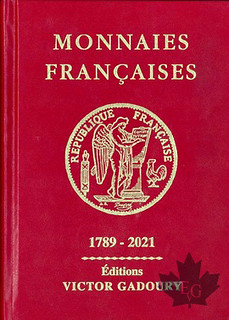 Monnaies Françaises, 1789-2021. 2022 edition
Monnaies Françaises, 1789-2021. 2022 edition
$48.95
Monnaies Françaises has been the bible for the coins of modern France since it was first published in 1973. It is now authored by Francesco Pastrone and published by Editions Victor Gadoury of Monaco. In French, it is called "Le Rouge" (The Red). It is published every two years.
The 25th edition, covering the years 1789-2021 is now available with all illustrations in color and a number of new features. Among them are many essais & pieforts with new photos - A chapter for Napoleon I (essais-Piéforts- Epreuves- Flans Brunis), All the silver and copper coins of Napoleon in Italy - A new coin from Monaco - The latest coins of the Monnaie de Paris. In addition to more pictures in high quality, the book also has more than 500 additional photos showing many close-up details.
It is now 608, full-color pages, and only $48.95. It has information on all French coins minted since the Revolution of 1789 through the current Fifth Republic in chronological order by denomination (smallest to largest), including both the circulation and collector issues of France's modern euro coins.
Also given are: metal, fineness, weight, diameter, edge, engraver's name and privy marks. Mintage figures are provided by date and mint mark for each denomination, along with accurate current values in euros in up to five grades. Also included are obsidional coinage for the sieges of Mainz and Antwerp and special sections on commemorative coins, coins of Monaco, coins of Corsica (1736, 1762-68), coins of Saarland (1954-55), and an illustrated guide of all privy marks.
Several coins are being published for the first time: For France: the 5 francs Louis XVIII 1818 T Nantes, with the different de Pierre Athénas: anchor
; the 5 francs of Louis-Philippe 1845 Lille with the obverse of the 2nd type; a new type of 20 francs Napoleon I: year 13 minted in Paris, and 1806 I Limoges (no period after Française).
For Monaco, there is an exceptional coin, the half-ecu or 30 soles of Honoré II dated 1643.
ISBN 2906602469
608 pages, hard bound
5.8 x 8.2 inches
Published by Editions Victor Gadoury, Monaco
For more information, or to order, see:
MONNAIES FRANÇAISES 2021
(https://www.gadoury.com/en/books/monnaies-francaises-2021)
Monnaies Françaises, 1789-2021. 2022 edition
(https://www.coin-currency.com/page315.html)
NEW BOOK: RUTHENIAN COINAGE OF LITHUANIA
A new book on Lithuanian numismatics has been published. -Editor
Regional coinage on Ruthenian lands of Grand Duchy of Lithuania at the end of 14 c.
by Dzmitry Huletski, Konstantin Petrunin, Andrey Yakovlev
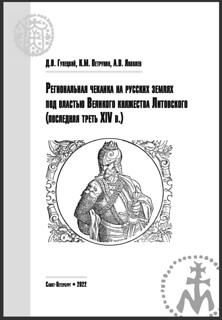 Great Duchy of Lithuania was on unprecedented rise in 14 c. Over one hundred years its area expanded
several times thanks to annexation of former lands of Polackian duchy & Kievan Rus. Many of these
lands at the brink of Lithuanian conquest were governed by members of Rurickovichs, some were more
or less controlled by Golden Horde. Weakening of mongol state in late 14 century facilitated eastward
expansion of GDL. And shortly afterwards local currency emissions began spreading out in former area
of Juchid dang circulation. Mints may have been controlled by Hediminovichs or by members of local
elites.
Great Duchy of Lithuania was on unprecedented rise in 14 c. Over one hundred years its area expanded
several times thanks to annexation of former lands of Polackian duchy & Kievan Rus. Many of these
lands at the brink of Lithuanian conquest were governed by members of Rurickovichs, some were more
or less controlled by Golden Horde. Weakening of mongol state in late 14 century facilitated eastward
expansion of GDL. And shortly afterwards local currency emissions began spreading out in former area
of Juchid dang circulation. Mints may have been controlled by Hediminovichs or by members of local
elites.
Coins bearing emitent's name or symbols amount to maybe less than half of such coin types, majority of coins were imitating Juchid dangs and authorization of their issue remains more or less murky. Imitational coinage allowed to fill local money supply with type of coins known to population of these areas and economical reasons may have been prevailing over political declarations especially in borderlands. Regional coinage mirrored existing monetary system, with various weight standards and ratios to Juchid dang.
After Olgerd's death and in times of constant civil wars between Hediminovichs local centers of emission began appearing in western part of GDL as well – in Podolie, Volyn, Belcs and Novagrudak. Practically the whole regional coinage is dated last third of 14 c. At the beginning of next century all regional coinages discontinued and Vitovts unified currency began spreading over the whole nation accompanied only by international trade currency Prague grosz and silver ingots.
This study is a result of collection and analysis of various data on regional currency issues of GDL on newly annexed Ruthenian lands in the 1370-1400 years. Our aim was to put together results of previous studies and bring forward a catalogue of all coin types known by the date of publication. Over 3000 specimens have been studied with more than 1000 die links introduced in this book, with graphic reconstructions and weight data where available.
NEW BOOK: SELEUCID COINS IN CENTRAL ASIA
Classical Numismatic Group has published a new book on Seleucid coinage by Brian Kritt. -Editor
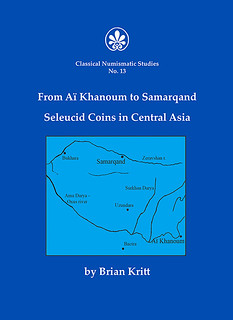 Kritt, Brian, From Aï Khanoum to Samarqand. Seleucid Coins in Central Asia [Classical Numismatic Studies No. 13]. Lancaster, PA, and London, 2021 Hardbound with dust jacket. 106 total pp. (GR 363).
Kritt, Brian, From Aï Khanoum to Samarqand. Seleucid Coins in Central Asia [Classical Numismatic Studies No. 13]. Lancaster, PA, and London, 2021 Hardbound with dust jacket. 106 total pp. (GR 363).
From the author's synopsis:
"The recent publication of ancient coins found at the site of ancient Samarqand sheds remarkable new light on the little-known history of Sogdiana in the period following the death of Alexander the Great. Scholars have attempted to understand the status of this region during the period of the Seleucids and their Greek successors in Bactria, posing and unable to decide upon theories of whether Sogdiana fell under the control of these Greek dynasties.
Lacking any definitive ancient accounts, they turned to numismatics to try to decide the issue. Unfortunately, the finds of coins from the relevant period had been scant, and misunderstood. The new finds at Samarqand provide a dramatic parade of bronze coins struck at the Seleucid colony at Aï Khanoum in Bactria, spanning the entire period of the Seleucid presence in Bactria, and beyond. The succession of the known types of these coins is remarkably well represented at Samarqand, providing the first detailed picture of the relationship between Seleucid Bactria and contemporary Sogdiana.
The results include the discovery of a Greek colony at Samarqand in the Seleucid period, with extensive contacts and interaction with Aï Khanoum. The lack of such finds elsewhere in Sogdiana indicates that the Seleucids had no substantive contact with the non-Greek areas, and thus had no interest in the conquering of all of Sogdiana.
Another important piece of the historical picture is revealed by the results of the recent excavations at the archeological site of the Uzundara Fortress in southern Sogdiana. The extensive finds of bronze coins of Euthydemus at Uzundara show the status of affairs involving the Greeks and the uprisings of natives from the north in the period of the invasion of Bactria by the Seleucid king Antiochus III during his eastern campaign.br> These and many other ramifications of these new coin finds are explored in Part A of this book.
Part B is an updated recording of the many new gold and silver coins of Aï Khanoum that have come to light since the publication of The Seleucid Mint of Aï Khanoum in 2016, with the identification of the new dies, and their rational incorporation into the corpus which was established in that treatise."
For more information, or to order, see:
New Discoveries in the Numismatics and History of Sogdiana in the Hellenistic period
(https://www.cngcoins.com/Coin.aspx?CoinID=394721)
FROM AÏ KHANOUM TO SAMARQAND: SELEUCID COINS IN CENTRAL ASIA.
(https://www.numislit.com/pages/books/6697/brian-kritt/from-ai-khanoum-to-samarqand-seleucid-coins-in-central-asia)
NEW BOOK: GERMAN TOKEN CATALOGUE 2022
Yosef Sa'ar writes:
"Wertmarkenforum, the German online token forum has an outstanding offer for 2022. They are offering at no charge the 2022 digital edition of Peter Menzel's masterwork on German tokens, eight volumes, 10,772 pages!"
Wow! Yosef provided this Google translation of the announcement. Thanks. -Editor
Dear token collectors and friends,
I wish you all the best for the New Year 2022, which has just started!
I am particularly pleased to be able to inform you today - as already mysteriously indicated - that Peter Menzel is now making his new emergency money and tokens catalog (3rd digital edition 2022) available for download free of charge on Wertmarkenforum.de.
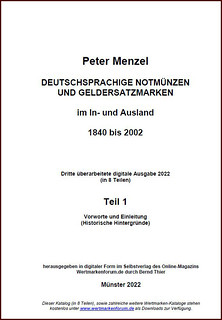 For exactly 40 years, "Der Menzel" has been the reference and standard work for all collectors of emergency coins and money substitute stamps. Over the decades, Peter Menzel has created a catalog that is second to none.
For exactly 40 years, "Der Menzel" has been the reference and standard work for all collectors of emergency coins and money substitute stamps. Over the decades, Peter Menzel has created a catalog that is second to none.
From the first one-volume and partially illustrated edition in 1982, still published by transpress-Verlag in what was then the German Democratic Republic, to the current third digital edition in 2022, the number of coins and stamps recorded has increased many times over.
Due to the size of the entire work (10,772 pages), the catalog is made available individually in 8 parts while maintaining the previous division.
These PDFs are freely digitally searchable for terms, inscriptions, place names, names, etc.
You can find these downloads either in the special article on this new release at
https://wertmarkenforum.de/peter-menzel-wertmarkenkatalog/
or on the specially newly set up subpage
https://wertmarkenforum.de/wertmarkenkatalog-von-peter-menzel/
Of special interest to U.S. military token collectors will be Part 7, covering tokens of U.S. facilities in Germany. -Editor
LIBRARY OF COINS ALBUMS VALUE GUIDE UPDATED
Researcher and author Dave Lange has published an updated value guide for Library of Coins Albums. Here's a copy of his announcement. Dave can be reached at DavidWLange@outlook.com . -Editor
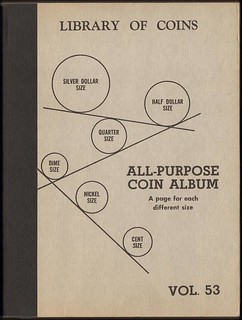 When I published a Check List & Value Guide for Library of Coins and Treasury of Coins albums in 2019, these albums were more commonly seen on eBay and other online sales platforms. Since that time the supply has nearly dried up, and prices are commensurately higher. This is especially true of the supposedly "common" Library of Coins albums for 20th Century coin series that are in the greatest demand.
When I published a Check List & Value Guide for Library of Coins and Treasury of Coins albums in 2019, these albums were more commonly seen on eBay and other online sales platforms. Since that time the supply has nearly dried up, and prices are commensurately higher. This is especially true of the supposedly "common" Library of Coins albums for 20th Century coin series that are in the greatest demand.
An updated CL&VG is available, with the price increases and newly-discovered varieties of Library of Coins albums shown in red. The Treasury of Coins line has remained stable, with no new varieties or price increases, and this reflects the lower demand for this junior line of albums.
All listings are keyed to my book Coin Collecting Albums---A Complete History and Catalog, Volume Two.
Dave adds:
"I'll send it to anyone free as a pdf. Those wanting a hardcopy may send a SASE for it."
To visit Dave's website, see:
https://www.coincollectingboards.com/
GOLD DOLLAR SALOON OPEN ON NEW YEAR'S DAY
The latest addition to the Newman Numismatic Portal is a great New Year's item about the Buffalo, NY Gold Dollar Saloon. Project Coordinator Len Augsburger provided the following report. Thanks. -Editor
Gold Dollar Saloon of Buffalo, NY Open on New Year's Day
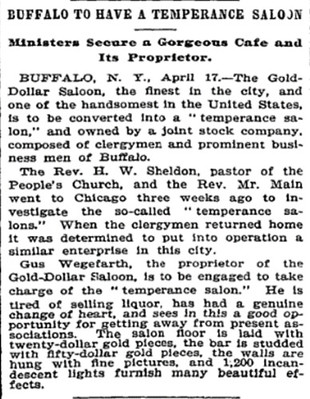 Opening New Year's Day 1870 in Buffalo, NY, the Gold Dollar Saloon lived up to its moniker, featuring a floor and bar inlaid with thousands of gold and silver coins. Coins continue as decorative items today, featured in objects ranging from toilet seat covers to Lucite tchotchkes. Rich Kelly and Nancy Oliver researched the Gold Dollar Saloon and reported their findings in the August 2015 issue of The Numismatist. Said to have cost over a $100,000 at the time of its construction, the bar reputedly contained $50
Opening New Year's Day 1870 in Buffalo, NY, the Gold Dollar Saloon lived up to its moniker, featuring a floor and bar inlaid with thousands of gold and silver coins. Coins continue as decorative items today, featured in objects ranging from toilet seat covers to Lucite tchotchkes. Rich Kelly and Nancy Oliver researched the Gold Dollar Saloon and reported their findings in the August 2015 issue of The Numismatist. Said to have cost over a $100,000 at the time of its construction, the bar reputedly contained $50 slugs
and other desiderata.
The New York Times reported on April 18, 1895 that the proprietor was tired of selling liquor
and was moving to temperance
format, following a similar movement in Chicago to make bars alcohol-free. A minor theft, not surprisingly, was reported in 1900. The contents of the Gold Dollar Saloon must surely have passed into normal numismatic channels at some point, but no mention is found on Newman Portal or other databases.
Image: Clip from New York Times, April 18, 1895, related to the Gold Dollar Saloon in Buffalo, NY
Link to The Numismatist on Newman Portal:
https://nnp.wustl.edu/library/publisherdetail/510969
VIDEO: 2022 FUN SHOW COMMERCIAL
These are selections from the David Lisot Video Library that feature news and personalities from the world of coin collecting. David has been attending coin conventions since 1972 and began videotaping in 1985. The Newman Numismatic Portal now lists all David's videos on their website at:
https://nnp.wustl.edu/library/multimediadetail/522852
Here's a television commercial for the 2022 FUN Show. -Editor
VIDEO OF THE WEEK: FUN Coin Show Commercial.
VIDEO: 00:30.
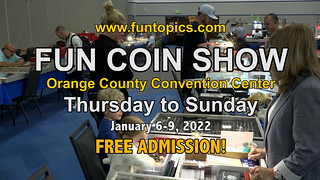 Producer David Lisot's comment: "I been doing a television commercial for the Florida United Numismatists Coin Convention for more then a decade. Each time I use images to provoke interest in the general public to make them want to find out more about numismatics by going to a coin show. The entire commercial is only thirty seconds so every word and picture is important. The voice over is done by my good friend and comic book expert John Petty. The commercial is aired on ABC, CBS, FOX, NBC, and Spectrum Cable in Orlando, Florida during prime time news."
Producer David Lisot's comment: "I been doing a television commercial for the Florida United Numismatists Coin Convention for more then a decade. Each time I use images to provoke interest in the general public to make them want to find out more about numismatics by going to a coin show. The entire commercial is only thirty seconds so every word and picture is important. The voice over is done by my good friend and comic book expert John Petty. The commercial is aired on ABC, CBS, FOX, NBC, and Spectrum Cable in Orlando, Florida during prime time news."
Are looking for a new hobby that combines investment, history, finances and fun? Then think about going to a coin
convention! The Florida United Numismatists are holding a coin show for collectors and investors, this Thursday through Sunday, at the Orange County Convention Center in Orlando. Hundreds of dealers will be there to buy and sell coins and precious metals. You'll be able to purchase American gold and silver Eagles at wholesale prices. Learn about old paper money and bank notes, Attend free seminars about coin collecting. And best of all, bring any kind of coin or money for a FREE appraisal. That's right, you can find out the value of your old coins and money. You'll want to bring the whole family to the Orange County Convention Center! Attend your first coin convention. This Thursday through Sunday. Doors open daily at ten and Admission is FREE!
It's the Florida United Numismatists coin show for collectors and investors. This Thursday through Sunday, at the Orange County Convention Center in Orlando. For more information go to: www.funtopics.com.
MORE WEBSITES FOR RESEARCHING ANCIENTS
Mark Fox submitted this article on additional online resources for researching ancient coins. Thanks! -Editor
Modern Way
by Mark Fox
The recent discussions concerning online resources for researching ancient coins attracted this writer's attention. Gradually, they made him realize the need for a fuller treatment on this very important topic. Numismatic websites in general help bridge the paper page with its digital counterpart, but rarely are these powerful research tools given any attention in either format other than the occasional short note stating that a particular site exists and offers to make the numismatic world a better place in one or more ways.
For ancient coin websites, the long-term plan is to go on an online safari of sorts and scour the
four poorly explored corners of the Internet for some big and useful classical numismatic game.
This current effort is intended to serve as an eye-opening taste of three websites that have so far
eluded the recent discussions. They illustrate what still lies in the digital jungles and why a
comprehensive list is badly needed. Let us not forget that websites like the ones under
discussion were created by everyone from shy, reclusive collectors to famous, scholarly
numismatists and institutions, and contain some very fascinating backstories. This part of our hobby is also a
part of our history. If we don't start collecting and preserving it now, we may lose a lot of
research gold in the very near future. And this doesn't even take into consideration the databases
themselves. Just this year, we lost the original ISEGRIM search engine (possibly the oldest
digital ancient coin database in the world) and Asia Minor Coins (which was a great research
stop for many ancient coin attributors like this writer). Thankfully, as already noted, there are
also some new and innovative online works in progress, two of which form a component of this
writer's taste.
Okay, time to open wide…
1. Roman Provincial Coinage Online (RPC Online): https://rpc.ashmus.ox.ac.uk/
This is hands down one of the best designed numismatic websites of any kind on the Internet.
Not only is this the opinion of this writer, but also of a collector with savvy web development
skills. It has been a fixture on the web since October 2006, wrought by a handful of dedicated
numismatists from the University of Oxford who, at the time, were just concerned with
cataloging the Roman provincial coins struck during the Antonine Period (A.D. 138–192).
Consider, from the pair of enclosed screen shots, how the project morphed, from 8th November 2006 to last Sunday. Now, the whole Roman provincial series
(from roughly 44 B.C.–AD 297) is not only slated to be booked
(in ten volumes) but also
webbed.
For a more thorough understanding on what RPC Online is all about, including what Roman provincials are and the importance of coin submissions from us collectors, this writer shockingly had the foresight to already write an article in support of the hallowed RPC cause, for the August 2015 issue of The Numismatist: https://www.academia.edu/15289195/Not_Built_in_a_Day_RPC_Online_
For a bit of interest, attached is one of the Roman provincials from my own collection that can be found on RPC Online, a bronze of the city of Tyana (in Cappadocia; 17mm, 4.08 g.), struck for Marcus Aurelius (A.D. 161–180). The photos are courtesy of Numismatik Naumann. See if you, the reader, can find the coin in the database!
Also, for those who relish the latest news, the following projection was personally provided by Dr. Andrew Burnett back in November of last year:
"The current plan is to try and get the Asia part of V online (V.2) for the Warsaw conference next year; and the rest of VI also sometime in 2022. In terms of printed volumes, next year should see VII.2 (the rest of VII) and after that IV.4 (which is only Alexandria – enormous enough for a volume on its own). So we're gradually getting there...!"
In a follow-up to this, he added:
"Maybe add that [RPC] VIII in print will be next after the others."
2. & 3. Numismatic Auction Database Explorer + Ancient Greek Coin Provenance Explorer
https://www.rnumis.com/auctions_top.php
https://www.rnumis.com/greek_coins_top.php
From an Internet mainstay such as RPC Online, we now focus our attention on two newly realized numismatic ambitions of Dr. Steven Moulding. The projects have been combined together like this since, as the names suggest, they are practically siblings. For this article, Steve was asked what inspired him to create these extremely handy digital tools, and that was all it took to open the floodgates of his enthusiasm! As such, this writer is going to sit back now, perhaps open an old auction catalog with ancient coins of religious and mythological significance that he will never be able to afford, and let Steve do the talking!
rnumis—the 'r' means research—was initially created in 2012, born out of a love for old
numismatic auction catalogs and a practical need to be able to easily access the information
within them. With existing websites, provenance research—for example—is fairly straightforward, provided the auction is after 1999. For sales before 1999, research gets either
expensive or a lot more time consuming. If you have a good library, you can open your catalogs
one at a time and start looking. It's fun, but it takes a while. For those catalogs that have been
digitized and made publicly available, for example by the ANS, BnF, or the University of
Heidelberg, you can do some searching online.
With rnumis, we want the research process to be easier and there are two tools that are under
active development. The first is the Numismatic Auctions Database Explorer. While the
underlying data is a key foundation of our other projects—such as the Provenance Explorer—we
find the tool to be very useful in its own right, serving as a handy date-ordered record of the
sales held by an auction house and their focus. Where possible, links are provided to online
digital catalogs. While it is by no means complete, there is reasonable coverage for auctions
with ancient coins—our main interest.
The second —and possibly more fun—tool is the Ancient Greek Coin Provenance Explorer.
The primary aim is to be able to easily check whether a coin in hand has appeared in older
auctions using as little information as possible. Weight, geographical region, metal, and issuing
authority can be used to get you closer, but even they aren't strictly necessary. The tool is visual,
meaning when you're done filtering, you can look at the results. No machine learning or
artificial intelligence, just the good old human eye. With luck, you'll find that a coin in your
collection came from an old sale. It's also fairly easy to spot unrecorded provenances. [See, for
instance, the attached and impressive provenance chain Steve managed to piece together for a
Tarentine half shekel.] Known provenances (from lot descriptions) can also be
easily checked and, if necessary, corrected.
Currently, the Provenance Explorer is restricted to Ancient Greek Italy and Sicily. Why?
Because, well, that's what we collect. It's also a (just about) manageable size project for one
person. However, there is no reason why the databases couldn't be extended and the same ideas
applied to Roman Coins or just about anything else. Finally, we should point out that the
provenance project is fairly new and so far only a small number of older auctions have been
included (coverage is noted on the website). We do plan to add many more sales, but data entry
is very time consuming. However, with almost 5,000 different Ancient Greek lots, there is
already enough to play around with.
So, as one can see, the variety and quality of online research tools for ancient coins (in addition
to those that had been detailed earlier) are quite vast and are constantly changing. However,
Fukube from the *Hyouka novel/anime mystery series (with his database
memory) will be the
first to tell you that databases are only as good as the person using them to solve problems. For
him, his Holmesian friend Oreki is a constant, if not painful, reminder of this, which raises the
need for yet another article project, this one on the tricks of using databases effectively and
flexing our deductive muscles!
*Note: Episode 19 of Hyouka contains one of the most amazing displays of deductive reasoning that this writer has ever seen in any form of media—and it concerns…well, just watch it (preferably subbed rather than dubbed to get the true flavor)!
To read the earlier E-Sylum articles, see:
ROMAN PROVINCIAL COINAGE ONLINE AT ASHMOLEAN MUSEUM
(https://www.coinbooks.org/esylum_v09n47a14.html)
ROMAN PROVINCIAL COINAGE VII.2 NOW ONLINE
(https://www.coinbooks.org/v23/esylum_v23n27a09.html)
ONLINE RESOURCES FOR ANCIENT COINS
(https://www.coinbooks.org/v24/esylum_v24n48a09.html)
ON BRONZED COPPER
Scott Miller writes:
"Regarding Chester Sullivan's inquiry about the term bronzed copper, it refers to a copper medal that was treated with chemicals, such as a bronzing powder, to give a red or dark brown finish. Many medals struck prior to the late nineteenth century were copper. To quote from R. W. Julian's Medals of the United States Mint
(see page XXXIII) "The term bronze is really a misnomer for the years prior to 1901. In reality the mint then struck copper medals which were chemically treated after striking; the proper name for the medals struck prior to 1901 is copper-bronzed medals."
"Julian then described medals struck from about 1825 to 1891 as having a proof surface and ranging in color from a light red to a dark brown, sometimes referred to as mahogany finish. Medals from about 1891 to 1910 or a bit later have a dull surface, and are usually dark brown, and referred to as dark chocolate medals. My own experience is that dark brown medals are referred to as having either mahogany or chocolate brown finish without distinction. "
Craig Sholley writes:
"Bronzing is the artificial patination of copper and its alloys by chemical means. In some methods, the metal was coated with a water-paste of various salts and oxides, such as copper tartrate, red iron oxide, and bone ash and dried on a hot plate or over an open fire. Treatment was repeated as necessary to achieve the desired color. Other "paste methods" used extremely hazardous materials like cinnabar (mercury sulfide) and red lead.
"Simpler aqueous methods were developed in the late 1600s using salt solutions made with water or vinegar. The vinegar solution of ammonium chloride and verdigris (copper carbonate, often with copper chloride and/or copper acetate) developed by the French was used by the US Mint and probably Boulton. However, there were a number of "bronzing powders" of various compositions available - just choose the one that provided the colors desired.
"Coins and medals are bronzed post-strike since striking would break the oxide coat during striking. The coins or medals are heated, placed in a copper pan, and covered with boiling bronzing solution. Chemical reaction creates a brown oxide coat of various hues, depending on the chemicals used and their proportions, along with the length of time they are left in the solution.
"Past authors such as Breen and Doty thought that planchets were coated with bronzing powder and the strike adhered it to the surface. I can only assume they thought this from the occasional piece seen with encrustations on the surface. However, the historical records clearly show that pieces were coated by the wet-chemical reaction noted above. Encrustations are the result of allowing the solution to evaporate from the surface of the medal or coin. Trying to "pound" what is essentially "dirt" onto the surface of a coin or medal obviously would not work.
"Since the Myddelton tokens were struck by Boulton in 1796, they were likely bronzed by John Middlehurst, Boulton's bronzing specialist, who also did the Monneron tokens (see Sue Tungate, "Matthew Boulton and the Soho Mint," 2010)."
Thanks, everyone! -Editor
To read the earlier E-Sylum article, see:
NOTES FROM E-SYLUM READERS: DECEMBER 26, 2021 : Query: Bronzed Copper
(https://www.coinbooks.org/v24/esylum_v24n52a11.html)
LOAN OFFICE CERTIFICATES
Website visitor Marion Painter of Astoria, Oregon posed a question this week. I added the illustration of a New Hampshire Continental Loan Office Certificate from the Eric P. Newman collection. -Editor
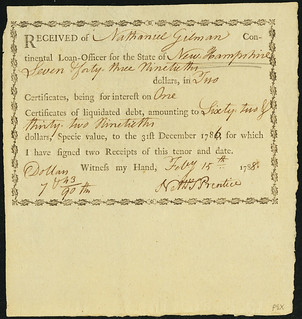 I am writing to you in hopes that you can point me in the right direction for information regarding Loan Office Certificates.
No, I do not own or am wishing to sell one - I just need to know what they are! It seems silly I know, but please have patience with me.
I am a genealogist and in reading through some wills I have come across the following in an estate inventory:
I am writing to you in hopes that you can point me in the right direction for information regarding Loan Office Certificates.
No, I do not own or am wishing to sell one - I just need to know what they are! It seems silly I know, but please have patience with me.
I am a genealogist and in reading through some wills I have come across the following in an estate inventory:
One Loan Office Certificate No 1566 for 600 D__
One Loan Office Certificate No 7913 for 300 D__
While the will was written in Brecknock Township, Berks County, PA in 1791, no mention was made of them. They are listed in the estate inventory as I said which occurred in 1796. The portion that they are included on also has other bonds and debts that were due to the deceased, so they appear to be an asset, not a debt. They are not assigned a value, just noted they were there and I don't know what to make of it.
Can you please tell me the best place to discover information on them? Was it an early banking situation?
I reached out to a couple friends who had great responses on this. First, here's what Tom Kays found in the Massachusetts Historical Society Collection of Nathanial Appleton. -Editor
This material consists of receipts and loan certificates for Revolutionary War debt received and issued by Nathaniel Appleton, Continental loan officer for the state of Massachusetts, from 1786 to 1792. The collection primarily consists of documents for the 1790 loan program created by Hamilton, but also contains certificates and receipts from earlier loan programs.
Alexander Hamilton proposed a new plan to fund the national debt. Rather than pay it off, he recommended the consolidation of old debts into new securities (stocks) with public revenues specifically pledged to pay their interest. Subscribers to these certificates of federal debt received a 6% stock issue, interest starting in 1791 and payable quarterly, equal to 2/3 the principal due. The final 1/3 came in the form of another 6% certificate of deferred interest that would start in 1801. Another stock certificate of 3% covered the interest due from December 31, 1789 to December 31, 1794. Hamilton's plan was ultimately a success, and what remained of the domestic war debt was paid off by individual states establishing sinking funds to retire any outstanding debt certificates.
To read the complete article, see:
United States Continental Loan Office, Massachusetts Receipts
(https://www.masshist.org/collection-guides/view/fao0002)
Joe Espositio passed along this excellent National Archives page. -Editor
"Old Loan" And Tax Records
During the Confederation and early federal period, the government raised revenues by borrowing money from private citizens, businesses, and foreign nationals. In exchange, the Treasury Department issued loan certificates and, later, stock. These "Old Loan" records can be used to determine individual wealth or affiliation with a business concern.
The earliest federal tax records containing information about individuals are from the Direct Tax of 1798. The National Archives has microfilmed the only records of this tax in its custody, the records of Pennsylvania.
Most federal tax records available to researchers, however, date from the Civil War. These Civil War records contain information on individual wealth. They may also be used to determine certain occupations, such as doctor, attorney, peddler, manufacturer, or dealer in spirits, because these professions were taxed separately.
Records of the Bureau of the Public Debt (Record Group 53)
The public debt functions of the Treasury Department go back to 1776, when loan offices were established in each of the 13 states by the Continental Congress. These offices were set up to receive subscriptions to the domestic loans for financing the Revolution. After the federal government was established in 1789, the first Secretary of the Treasury, Alexander Hamilton, continued the loan office system as part of his plan for funding the Revolutionary War debt. In 1817 the duties and records of the State Commissioners of Loans were transferred to the Second Bank of the United States, which had been chartered in the previous year, and the loan offices ceased to exist.
Continental Loan Office Records
The National Archives has microfilmed Continental loan office records for Connecticut, Delaware, Maryland, New Hampshire, New Jersey, New York, Pennsylvania, and Rhode Island. The records consist mainly of registers of loan office certificates and liquidated debt certificates. The loan certificate represents an early effort to fund the war and circulate the currency; the liquidated debt certificate was an instrument used to consolidate the public debt by settling the claims of individual citizens. In the absence of a circulating medium, certificates of interest ("indents") were issued on these obligations. Other types of records include registers of interest certificates, indexes, journals, ledgers, and accounts current.
Loan certificate registers typically consist of entries under specific denominations, arranged chronologically by date of issue with the name of the subscriber and serial number of the note. Some registers of interest certificates show the signatures of subscribers, but the records seldom show their addresses or other identifying information
To read the complete article, see:
Genealogical And Biographical Research:
A Select Catalog Of National Archives Microfilm Publications (Part 2)
(https://www.archives.gov/publications/microfilm-catalogs/biographical/part-02.html)
Thanks, everyone! Do readers have anything to add? Can anyone point us to larger collections of images of these certificates? -Editor
For more information on the Newman New Hampshire Continental Loan Office Certificate, see:
Lot 89389
(https://nnpbeta.wustl.edu/library/imagedetail/597255?col=512602)
NOTES FROM E-SYLUM READERS: JANUARY 2, 2022
More on the 1922 Havana Exposition
"The 1922 Havana Exposition seems to have been open from November 1922, through early 1923. The American magazine "Facts About Sugar" (Oct 21 1922) had an article about it. It can be found courtesy of Google Books.
The article states that the International Commercial Exposition will be held at the convent of Santa Clara of Asis and "held simultaneously with the Sixth Latin American Medical Congress, the National Maternity Concourse, and the International Exposition of Hygiene." The convent was said to date back to 1522 with the "picturesque old fountain" being "probably one of the most valuable archeological specimens in the Americas."
"I also found articles in the Charlotte Observer (North Carolina) in February 1923 reporting on the local company- Marietta Paint & Color Company of High Point winning a "gold medal and diploma" for quality and their Havana based manager (Mr. Pou) was given "a silver medal for the artistic effect of the exhibit." I didn't see mention of any bronze medals, but I hope this helps Michael somewhat."
To read the 1922 article, see:
Facts about Sugar, Volume 15
(https://books.google.com/books?id=dDo6AQAAMAAJ&pg=PA330&dq=
%22havana+exposition%22+1922&hl=en&newbks=1&newbks_redir=0&sa=X&ved=
2ahUKEwj-4JaVuPL0AhUUKX0KHVxODUsQ6AF6BAgCEAI#v=onepage&q&f=false)
Thanks! -Editor
To read the earlier E-Sylum article, see:
NOTES FROM E-SYLUM READERS: DECEMBER 19, 2021 : Query: Cuban Medal Information Sought
(https://www.coinbooks.org/v24/esylum_v24n51a11.html)
On Middle Names
R. Craig Kammerer writes:
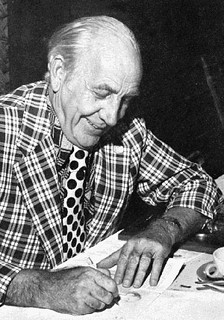 "Regarding the question of the name of Lee Hewitt - maybe I can shed a little light. I have vast experience in genealogy, having done true research for many decades. Note: true research does NOT mean search the net as the net is 95% bogus, being made up, due to people simply copying each other & almost all have no idea as to what they are doing.
"Regarding the question of the name of Lee Hewitt - maybe I can shed a little light. I have vast experience in genealogy, having done true research for many decades. Note: true research does NOT mean search the net as the net is 95% bogus, being made up, due to people simply copying each other & almost all have no idea as to what they are doing.
"Government people are truly OBSESSED with first names & will do anything to find one, no matter what. BUT, millions of families use exclusively middle names, using that name since the birth of their child. In many different census reports [taken every 10 years in the US since 1790, but in 1790, very few states took it or even existed then], I have found names switched by the census people, when they discover that the family used the middle name, but census agents refuse to use it, so switch it to the first name, creating a new name. Many a person has been lost
this way.
"Since space is limited, one blatant example is the famous band leader Glenn Miller. I visited the Cambridge England American cemetery to find my Dad's best friend, who was lost during WW2. On the memorial wall I found his name, & then decided to look up Glenn Miller, who was lost over the English Channel in 12/1944, during a flight from England to France. BUT, his name was not on the wall. Thus, knowing what I do re government bureaucrats, I decided to look up all Millers & sort through them all [units & occupations were also given]. Finally found him under the name ALTON
. Some idiot found his birth first name & listed him only under that. Never mind, that in all Glenn's thousands of recordings, albums, concerts, broadcasts, movies & even movies about him, NOT ONCE was the name Alton ever used!! NO ONE HAS EVER heard of it!!! So now, I was sure that many who looked up Glenn here, never found him at all.
"In my research, I now assume that some bureaucrat has messed up many names & look accordingly.
"Best
Craig [that's my middle name]"
Good points! Thank you. -Editor
To read the earlier E-Sylum article, see:
LEE F. HEWITT (1911-1987)
(https://www.coinbooks.org/v24/esylum_v24n52a14.html)
Webinar: Collecting and Chasing Rare Books
"I got an invitation from the New England Historic Genealogical Society for a free webinar on Friday, January 7 (4-5pm). It is a presentation by Ken Gloss of the Brattle Book Shop here in Boston ("The Thrill of the Hunt: Collecting and Chasing Rare Books"). You don't have to be a member of the NEHGS to sign up (though I have been a member for a long time). While it isn't numismatic in focus but it is definitely for bibliophiles and I have bought a number of things from his shop over the years."
Thanks. Here's the link. -Editor
To read the earlier E-Sylum article, see:
The Thrill of the Hunt: Collecting and Appraising Rare Books
(https://hubs.americanancestors.org/thrill-hunt-rare-books?)
MORE ON THE FUTURE OF LIVE AUCTIONS
Fred Holabird of Holabird's Western Americana Collections, LLC submitted these thoughts following Jeff Garrett's piece on the future of online auctions. -Editor
 Over the last two years, there has been much discussion of how Covid changed the auction markets.
Over the last two years, there has been much discussion of how Covid changed the auction markets.
Covid was not the key mechanism of change to the Live auction business. The change came gradually, through time, as a direct result of a changing and advanced technological world.
Like Jeff, and many, many others, we lament the loss of the old fashioned live auctions with a room, or rooms, full of prospective bidders. Yes, there was often psychology involved between competing bidders. But perhaps the most important thing which Jeff and all of us older folks realize, is that auctions brought together a community of collectors. It is where we all met, let our hair down, became friends or acquaintances, grew relationships and enjoyed the camaraderie of collecting as a group. As the shows grew larger, it became impossible, as Brian noted, to leave the bourse to inspect items for auction.
There have been major technological advances. Both John and Ian noted very correctly that imaging technology has been a game changer. How many of you remember the booth fifteen years ago at a national ANA show where three dimensional photography was first introduced, in the back of the bourse, next to Northwest Territorial Mint's booth? I was enthralled, so much so, that we experimented with it more than a decade ago with a South African company and high-end mineral specimens.
Another major technological advance has been the development of multiple, competing online auction platforms. Today, everybody wants to be an auctioneer. It seems there are as many auction companies as Starbucks – one on every corner. But those that grasp the underlying keys of this new and constantly changing technology will be the successors. In our own case, we use as many as five different competing platforms at one time.
Each of the commentors is correct – we are seeing a new breed of collectors (and buyers) by this massive increase in internet auctions. It has brought the fun of collecting back into the marketplace, making it accessible to multiples of the attendees to a single trade show, and introducing new collecting genres to thousands of collectors worldwide. This facet of marketing does not eliminate the need for trade shows. In fact, it makes them even more important, as we can all promote the trade shows to do what we all used to do – meet the collectors, discuss collecting, and all the things associated with it in person, and further develop those cherished relationships.
Our company finds itself making hundreds of new collectors every sale, with a huge number of registered bidders. During the live auctions, we promote the collecting clubs, the trade shows, and the dealers who take the time, money and expertise to offer goods to collectors. We hope all of you do the same!
In a similar vein, Antiques Trade Gazette published an article this week on "Doing the bidding of the Amazon generation." Here's an excerpt. See the complete article online for more. -Editor
The pandemic restrictions speeded up a process that many auctioneers thought would take some time: a seismic shift towards online bidding. While boosting business, it also means salerooms need to adapt to meet the demands of internet-savvy customers
Auction bidders keen for a bit of social distancing alongside their paddle waving might be eager to flock to Dawsons in Maidenhead, Berkshire, when the firm opens the doors of its new 12,000 sq ft premises in January.
But they will discover they are in the wrong place. Despite so much space, the firm will be running all its sales online with no room bidding. Put that paddle away: the auction action these days is to be found in the comfort of your own home.
We went online at the start of the pandemic in March 2020 and have had no room bidding since then,
says managing director Aubrey Dawson. In 2022 he will be broadcasting from a dedicated live streaming room where everything is geared up for online-only
.
The profile of the buyer is changing,
says Stephan Ludwig, founder of Forum Auctions (now part of Gurr Johns where he is co-chief executive). As a business we want to attract the Amazon generation. We need to move towards accommodating this buyer's mentality and attract more of them.
With viewings off-limits for a while during the pandemic – and now by appointment-only at many venues – auctioneers responded by raising their game in cataloguing.
They have been providing more and better photographs of lots, greater detail in descriptions and more condition reports as standard. This practice continued and even accelerated out of lockdown as it became clear that buyers had become comfortable researching lots from home.
At David Lay Auctioneers in Penzance the furniture photographs for its recent Personal Collection of Jonathan Grimble sale would not have looked out of place in a top high-street store's catalogue.
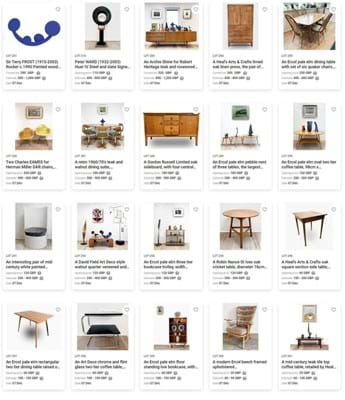
We now have two full-time photographers,
says chairman and owner David Lay. They are young local people who have studied photography at Falmouth University and are brilliant. They have such great ideas and skills and enable us to do exciting things with new presentations and layouts.
Ed Crichton, partner in Lacy Scott & Knight's fine art department, says his Bury St Edmunds firm has also invested in more staff and more time to photograph items – some lots will get as many as 10 photos or more
.
The rise in remote bidding was a key factor in this decision. Now about 70-75% of all bids come online while it was 45-50% pre-pandemic,
he says.
In Stansted Mounfitchet, Sworders now employs four full-time photographers and is seeking to recruit more
Pre-sale we now also provide a comprehensive condition report on every lot we sell,
says chairman Guy Schooling, Yexue Li, who runs our Asian Art sales, took a minimum of 20 additional photographs for every lot that she offered in her sale; more than one lot had 100 additional images.
To read the complete article, see:
Doing the bidding of the Amazon generation
(https://www.antiquestradegazette.com/print-edition/2021/december/2523/review-of-the-year/doing-the-bidding-of-the-amazon-generation/)
To read the earlier E-Sylum article, see:
THE FUTURE OF LIVE AUCTIONS
(https://www.coinbooks.org/v24/esylum_v24n52a17.html)
VOCABULARY TERM: RELIEF
Here's another entry from Dick Johnson's Encyclopedia of Coin and Medal Terminology. -Editor
Relief. The three-dimensional surface that is the design on a plane other than that of a base, background or field. Relief sculpture has three dimensions, height and width are normal, but the third dimension – depth – is highly compressed. The viewer is not generally aware of the background, which is well behind, near the same, or in front of, the relief design. But what the viewer sees is the modulated relief that forms the design.
The background – called matrix by sculptors, the table by manufacturers, and the field by numismatists – is always attached to the relief. If the three-dimensional design is not attached to such a background then it is free standing or sculpture-in-the round. (Because of this attachment to the background and its depth compression, relief is whimsically called "two-and-a-half dimensions.")
For numismatic items relief is the design surface that rises above (infrequently below) the table or field of the model, coin or medal. The sculptural modeling of bas-relief – low relief or very low relief – that is capable of making such models required for coin and medal dies is employed extensively.
Types of relief. Relief is distinguished by the degree it extends above the background; also there are two categories where the relief is below the background, all explained below. But there is one concept that is very important among these categories – undercut, undercutting – the carving of overhang between the relief and its matrix.
-
High Relief (Italian alto-rilievo) extends the greatest amount above the background – more than half – and contains a great deal of undercutting to make the relief stand out extensively from the background. It has no application to medallic or numismatic art. [Caution: some medals are claimed to have
high relief
this is not this sculptural definition of high relief; see below.] - Medium Relief or half relief (Italian mezzo-rilievo) is similar to high relief, but does not extend as much away from the background. Again undercutting is present, from moderate to extensive amount. Impossible for diestruck pieces, it can be molded or cast. A few cast plaques with this relief are found in medallic art.
- Low Relief or bas-relief (Italian basso-rilievo). No part detached from the background and no undercutting. Bas-relief, the French word for this relief, is used extensively for medallic work, particularly for multiple-struck medals; there are no undercuts which allows for a piece to be cast or diestruck and easily removed from the mold or die. There are sides to the relief where the designs meet the background, the more perpendicular the sides the greater the emphasis of the height of the relief. But all sides must slant with a slight draft or bevel for the piece to be released from its die or mold). Thus for medallic work this relief must meet some severe technical restrictions.
- Very Low Relief or coin relief (Italian stiacciato). Absolutely no undercutting, height of relief the very least. Most suitable for coin modeling, and ideal for diestruck high speed coining. However the technical restrictions are even more severe: no sides to the relief (it must end right at the truncation with the background), the total rise of modulated relief to the high point is critical (it must not rise above a certain height), there should be no sharp increase of relief, and no deep protrusions of small areas (like the center of letters, A and O for example). This type of relief is so important to the numismatic field, it has a separate entry in this encyclopedia. See stiacciato.
- Hollow Relief or coelanaglyptic relief (Italian cavo-rilievo). This is raised relief in a sunken panel, the height of the relief does not exceed that of the background or table; also called sunken relief.
- Intaglio or incuse relief (Italian intaglio rilievo). Negative relief, completely sunken below the background or table; also called sunken relief, it is the opposite of cameo or raised relief.
Relief in medallic art. In his book on the medals of the Pinches firm, John Harvey Pinches grouped all the firm's medallic work into five classes of relief: coin, shallow, bold, high and very high; with high relief being most prevalent. Obviously medallic high relief is not the same as sculptural high relief (with extensive undercutting and more than half the form extending from the matrix or background).
Thus medallic relief is measured with a different yardstick while using the same terms. All medallic relief falls within sculptural low relief (bas-relief) or lower–coin relief (stiacciato) or incuse or hollow relief. Encountering sales literature extolling the delight of a medal's high relief
(often written by someone with little experience in either sculpture or numismatics) may confuse the reader. It may talk about one but explain the other.
Medallic high relief should be considered as high low relief – the highest relief found in low relief class – a sort of sub-category. Likewise bold medallic relief is a further grade down within the low relief class; shallow is a grade down more so. Coin relief is coin relief in both scales – it can only mean the relief to produce coin models with extensive restrictions.
How relief is formed and shaped. Relief can be modelled in soft material, as clay, wax or plasteline; or it can be carved – in plaster, wood, stone or such – or infrequently relief can be formed by hammering thin sheets of metal from the back (repoussé). Further, by plaster casting, relief can be transferred from positive to negative, or negative to positive.
Thus to form raised relief the artist may carve in the negative or add material (clay, plasteline) to the positive. Conversely to form incuse relief the artist may carve in the positive or add material to the negative. He can work whichever way he is most comfortable. See modeling.
Much of what the sculptor does is creating undulating or modulated relief – the rise and fall of design. If all relief was of one plane raised from the background (silhouette relief), it would look too mechanical and not at all be realistic. Machines can, indeed, cut relief in this style, but it is for an artist to prepare a design in modulated, soft flowing relief that is most attractive to the human eye.
Effect of light and shadows. The purpose of all relief is to create an interplay of light and shadows in the sight of the viewer. Thus, higher relief can do this easier than low relief, but each type of relief has a charm of its own. Knowledgeable artists realized this, of course, and make use of all relief for its interpretation by the human eye.
Also when creating the models, the material is usually of monochrome color (as all white plaster, all gray clay or such). The artist tilts his model often to catch the differ- ent effect and mood created by the shadows. The position of his light source (lamp, window, sun) is important during modeling, the reason so many artists prefer a north light in which to work. Creating the modulated relief is controlling somewhat the shadows of the piece; this is important for the artist as it is for the viewer, or as it is for the photographer of the piece.
Scope of relief. It must be remembered that the relief models for coins and medals are quite small. Relief can range from the medalet to the monumental. Mount Rushmore can be considered a relief carving and its creator, Gutzon Borglum, also crafted the patterns for coins and medals. Once the artist reaches a level of proficiency in relief sculpture, the scope can vary.
This is evident in other relief objects created by the coin and medal artists as well. These same artists have also produced tablets, architectural reliefs, bronze doors, and medalist John Flanagan even created the relief decoration for the clock in the Library of Congress.
Cataloging relief. In cataloging coins the type of relief – unless it is sunken or incised relief – need not be mentioned, as all coins are in very low relief or stiacciato. Medals, however, can be in any of the reliefs described above. A medium relief is considered normal – all others should be identified in cataloging.
To read the complete entry on the Newman Numismatic Portal, see:
Relief
(https://nnp.wustl.edu/library/dictionarydetail/516615)
ROBERT FRIEDBERG (1912-1963)
American Numismatic Biographies author Pete Smith submitted this article on Robert Friedberg. Thanks! -Editor
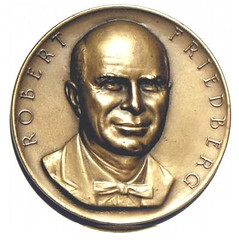 Many of today's veteran collectors visited their first coin shop at a large department store. For
me, it was in the Dayton's Department Store in Minneapolis. These stores were affiliated with
Robert Friedberg and the Capitol Coin Company.
Many of today's veteran collectors visited their first coin shop at a large department store. For
me, it was in the Dayton's Department Store in Minneapolis. These stores were affiliated with
Robert Friedberg and the Capitol Coin Company.
Robert Friedberg was born in Atlantic City, New Jersey, on November 7, 1912. In early records his name is shown as Rubin. His parents, Harry and Sarah, were immigrants from Russia. They had another son known as Jack but in the records as Jacob. Young Robert acquired world coins from sailors who visited his father's tailor shop.
He graduated from Boys High School in Brooklyn and then attended College of the City of New York 1930 to 1932 and Brooklyn College 1933 to 1935. While in college in 1931 at age 18, with his 16-year-old brother Jack, he founded Capitol Coin Company in the mail order business. He was inducted into the Army for service during World War II. While in the service in Europe, he acquired more coin inventory.
In 1947 he was hired by Jacques Minkus to manage the coin department at Gimbels in New York. Working in the stamp department there was Goldye Nessanbaum. They were married on January 25, 1948. Their two children were Ira Seth and Arthur Louis Friedberg.
With Minkus managing the stamp side and Friedberg on the coin side, they established franchise coin shops in leased space in 38 major department stores around the country. Coins purchased at these stores were sent to New York and then redistributed as needed to the various stores. The parent company published price lists that were overprinted with the names of the local stores. When the Professional Numismatists Guild was organized in the 1950's, Gimbels Coin Department was listed as one of the original members.
Robert was president of the Coin and Currency Institute from 1955 until his death in 1963. They
published books for collectors and handled coin supplies. In 1959 they introduced the Library
of Coins
albums that outperformed the previous National Coin albums. David W. Lange has
published a book with a biography of Friedberg and the story of his companies.
Robert died after an eight-month illness in the hospital in Hackensack, New Jersey, on June 14, 1963. He is buried at Menorah Cemetery in Clifton, New Jersey. He was inducted into the ANA Numismatic Hall of Fame in 1986 and the SPMC Hall of Fame in 2014.
After recent discussion of 100-year-old numismatists, the subject this week lived only to the age of fifty. In his short life he had an important role in expanding the hobby with his reference books, albums and shops in popular department stores.
His family continued to operate the business following his death. His brother Jack (1914-1998)
continued Capitol Coin Company and the Coin and Currency Institute until retirement in 1977.
Goldye remarried in 1972, became president of the company in 1977 and died in 1991. His son
Arthur was noted as one of The most influential people in numismatics 1960-2020
by Coin
World in 2021.
I have a medal with the name and image of Robert Friedberg. The edge is marked MEDALLIC ART CO, NY. Below the truncation is the name of Ralph J. Menconi. It is uniface so there is no hint of the reason why it was struck. I reached out to David W. Lange for an explanation.
Lange reported that the Coin and Currency Institute produced the medal as a tribute to Friedberg after his death in 1963. The reverse was personalized and sent to the managers of coin stores in the chain, possibly as many as 38. The medals Lange and I have are unengraved. We would be interested to hear of any engraved examples in collections.
Interesting. Can anyone help? Who has one of the personalized medals?.
Growing up in Pittsburgh two of the top local department stores were Kaufmann's and Gimbels, and I believe both had coin shops that I visited as a young collector. We've published reader recollections of these shops in the past. Anyone have a story to add? Thanks. -Editor
To visit the Coin and Currency Institute website, see:
http://www.coin-currency.com/
HARVEY STACK'S NUMISMATIC FAMILY, PART 112
The latest article in Harvey Stack's blog series covers the auction sales of 1992. Thanks, Harvey. -Editor
1992 was a major year of auctions for Stack's. We started the year off in January with the Winter Collection, an extensive offering of United States colonial and federal coinage that included gold, silver and copper plus territorials and pattern and numbered 1,468 lots. March brought a similar outstanding collection of United States gold, silver and copper coins, plus a large and important offering of U.S. patterns. This sale of over 2,100 lots gave buyers a significant opportunity to acquire scarce and choice coins collected over several decades, many from famous pedigree collections.
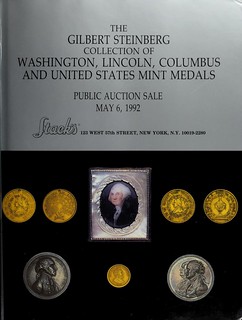 Our May sale was once again held in conjunction with the annual Metropolitan New York Numismatic Convention and featured three important collections. The first was the Gilbert Steinberg Collection of Washington, Lincoln, Columbus & U.S. Mint Medals, a cabinet of outstanding quality and rarity. It was one of the most extensive such collections sold and attracted specialists from all over America. The catalog of 377 lots was enthusiastically received. The second catalog for our May sale was a classic collection of U.S. paper money offering a superb, high quality array of various denominations and including pieces from the very origins of currency in America. Many of the specimens among the 861 lots were considered unique and collectors from all parts of the country scrambled to purchase these rare notes. The sale was
Our May sale was once again held in conjunction with the annual Metropolitan New York Numismatic Convention and featured three important collections. The first was the Gilbert Steinberg Collection of Washington, Lincoln, Columbus & U.S. Mint Medals, a cabinet of outstanding quality and rarity. It was one of the most extensive such collections sold and attracted specialists from all over America. The catalog of 377 lots was enthusiastically received. The second catalog for our May sale was a classic collection of U.S. paper money offering a superb, high quality array of various denominations and including pieces from the very origins of currency in America. Many of the specimens among the 861 lots were considered unique and collectors from all parts of the country scrambled to purchase these rare notes. The sale was standing room only
as buyers fought to acquire some items not seen for decades.
Finally, our third May catalog featured over 1,200 lots of varied gold, silver and copper denominations that had great appeal for collectors attending this noteworthy convention. The variety offered gave less specialized enthusiasts the chance to bid on valuable U.S. coins from different consignors. These three catalogs made for a very special convention auction in 1992.
In June our sale combined specialize smaller consignments from a group of collectors and we were able to offer a comprehensive catalog of United States coins, in various grades, including many scarcer mintmarks. The 1,697 lots were typical of our sales that provided "something for everyone" from the developing collector to the advanced specialist. Auctions like this started many collectors on their way and, as they developed, such sales also provided the opportunity to improve their collections with choicer or rarer dates. Likewise our September sale served our varied base of collectors and allowed buyers to fill some of the missing links
in their growing collections.
 In October 1992, we were pleased to offer more from the prize-winning collection of Floyd T. Starr, an impressive cabinet that Stack's had helped build over the years. This was a comprehensive United States coin collection, from outstanding colonial American coinage, through the most sought-after coins of the early U.S. Mint to coins of the 20th century. Many rare and important pedigree coins were included, and finest known examples offered a great opportunity for specialized collectors to add such rare pieces to their holdings. Stack's earlier sale of the Floyd Starr Collection set the pace for this offering as it too featured the rarity, quality and pedigrees that were hallmarks of this fine cabinet. The October 1992 sale had 1,365 lots of world class specimens and there were thousands who bid by mail, phone or in person. For many, this was a once in a lifetime opportunity to acquire such pieces.
In October 1992, we were pleased to offer more from the prize-winning collection of Floyd T. Starr, an impressive cabinet that Stack's had helped build over the years. This was a comprehensive United States coin collection, from outstanding colonial American coinage, through the most sought-after coins of the early U.S. Mint to coins of the 20th century. Many rare and important pedigree coins were included, and finest known examples offered a great opportunity for specialized collectors to add such rare pieces to their holdings. Stack's earlier sale of the Floyd Starr Collection set the pace for this offering as it too featured the rarity, quality and pedigrees that were hallmarks of this fine cabinet. The October 1992 sale had 1,365 lots of world class specimens and there were thousands who bid by mail, phone or in person. For many, this was a once in a lifetime opportunity to acquire such pieces.
Our auction season closed out in December with another trio of collections, starting with a rare and choice offering of United States paper money types, a specialized collection of Puerto Rico banknotes, and a collection of U.S. Silver Certificates formed by banker James W. Thompson. The 382 lots brought many record prices from collectors who participated from all parts of America. This was followed by a comprehensive collection of U.S. gold, silver and copper coins assembled by Richard Yeager, enhanced by additional important collections. We concluded our December 1992 offerings with a sale of ancient and foreign coins and banknotes from the collections of Floyd T. Starr, Dr. Alfred Globus, Charles Wormser, Emillo Ortis, and Dr. Richard Ciccarelli. This auction featured scarce, rare and choice specimens from around the world and was welcomed by our bidders who focused on such things, as it was our first sale of the year that was not geared to United States items. The 1,684 lots presented covered a diverse selection to appeal to a wide array of collectors. We were happy to be able to end 1992 by serving our clients in all areas of numismatics.
To read the complete article, see:
Harvey Stack Remembers Growing up in a Numismatic Family Part 112
(https://www.stacksbowers.com/News/Pages/Blogs.aspx?ArticleID=harvey-stack-remembers-numismatic-family-part-112)
To read the earlier E-Sylum article, see:
HARVEY STACK'S NUMISMATIC FAMILY, PART 111
(https://www.coinbooks.org/v24/esylum_v24n51a16.html)
STAMP DEALERS BOGERT & DURBIN
In the early days the numismatic and philatelic communities were quite connected, with a large number of collectors and dealers handling both stamps and coins, and multiple periodicals covering both topics. This new article from John Lupia explores the history of the Bogert & Durbin firm, connections to Ebenezer Locke Mason, Jr., and Philatelic Monthly. Here's a short excerpt - see the complete article online at John;s NumismaticMall website. Thanks. -Editor
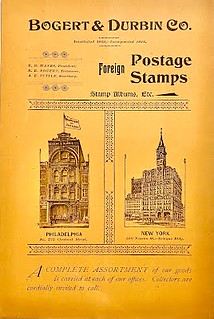 The firm of Bogert & Durbin that was incorporated in 1891 is a classic case of the power of branding. R. R. Bogert & Co., New York had for twenty years established a solid reputation and confidence in the global philatelic community. Durbin & Hanes, had done the same for a decade in Philadelphia. But it was four years after the death of L. W. Durbin in 1887 that Bogert & Durbin was formed with Edward Billings Hanes, as if concealing himself behind the name, became its first president. So let it be known that the firm of Bogert & Durbin was posthumous and contained no Durbin at all since he already had left this world four years before the company was formed.
The firm of Bogert & Durbin that was incorporated in 1891 is a classic case of the power of branding. R. R. Bogert & Co., New York had for twenty years established a solid reputation and confidence in the global philatelic community. Durbin & Hanes, had done the same for a decade in Philadelphia. But it was four years after the death of L. W. Durbin in 1887 that Bogert & Durbin was formed with Edward Billings Hanes, as if concealing himself behind the name, became its first president. So let it be known that the firm of Bogert & Durbin was posthumous and contained no Durbin at all since he already had left this world four years before the company was formed.
Rudolphus Ritzema Bogert (1842-1907), was born on February 17, 1842, son of Rudolphus Bogert (1811-1866), and Wealthy Jane Gordon (1819-1900), New York City, New York Postage Stamp Dealer. In 1874 he was a founding member of the National Philatelic Society. He had his first office at 227 Harrison Street, Brooklyn, New York, but later in early 1882 removed to the Tribune Building on Nassau Street.
He merged his business with Edward Billings Hanes and Arthur Elijah Tuttle forming a consolidation with Durbin and Hanes in 1891 renaming the merged companies Bogert & Durbin long after the death of Durbin. The firm had $75,000 operating capital. The board of directors included R. R. Bogert, Arthur E Tuttle, William F. Clement, and George R. Tuttle, Hanes was President of the firm, Bogert the Treasurer, and Arthur E. Tuttle, Secretary. They remained in both offices : Durbin & Hanes' city of Philadelphia, and in the Tribune Building, 60 Nassau Street, New York. The New York branch office occupied 1,500 square feet and had six salesman full time filling orders.
In 1896 Bogert took part as one of the founders of The Collectors Club, and help organize the American Philatelic Society.Bogert retired as a corporate officer in 1900.
In 1904, Bogert was Member No. 73 in the Stamp Collectors Association. He was also a member of the Canadian Philatelic Society.
Bogert died January 23rd 1907 just 3-1/2 weeks before his 65th birthday.
In 1910, Bogert & Durbin was sold to The United States Stamp Company.
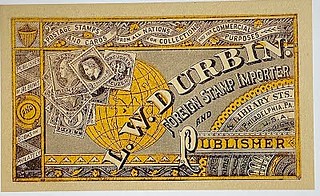 Leonidas W. Durbin (1849-1887) was born on August 18, 1849, in Rising Sun, Indiana. From 1861-1865 he served in the Quartermasters Office during the Civil War. In 1865 he entered the banking house of Gaylord, Leavenworth & Co., of St. Louis, Missouri. He moved from St. Louis to Philadelphia in April 1869 to join the firm of Mason & Co.
Leonidas W. Durbin (1849-1887) was born on August 18, 1849, in Rising Sun, Indiana. From 1861-1865 he served in the Quartermasters Office during the Civil War. In 1865 he entered the banking house of Gaylord, Leavenworth & Co., of St. Louis, Missouri. He moved from St. Louis to Philadelphia in April 1869 to join the firm of Mason & Co.
His stamp dealership was located at 129 South 10th Street, Philadelphia, PA; Burlington, New Jersey. He was formerly from St. Louis, MO. Stamp dealer partner with Ebenezer Locke Mason, Jr., to run the stamp department of Mason & Co.
L. W. Durbin stamp dealer in St. Louis, MO, who ran an advertisement in Mason's Magazine published on the cover. His photograph is published as figure 45 in Mason's Photographic Gallery of the Coin Collectors of the United States No. 1.
The second partnership of Ebenezer Locke Mason, Jr., which was to fund a Coin and Stamp Depot in New York was first met with a mishap when the gentleman Leon W. Durbin, of St. Louis, Missouri, had a near fatal accident with a dumb bell being struck in the head at his temple with a near fatal blow.
To read the complete article, see:
BOGERT & DURBIN
(https://sites.google.com/a/numismaticmall.com/www/numismaticmall-com/bogert-durbin)
ENGRAVER LORENZO HATCH
Susan Bremer published a nice article on engraver Lorenzo Hatch in the Heritage December 23, 2021 Currency News email newsletter. -Editor
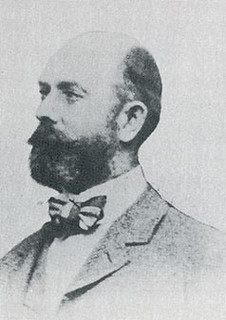 Many highly sought-after notes will be available in Heritage's upcoming FUN Auction. These auctions will showcase the works of many talented engravers. One of the few engravers found in both the US and World Currency is Lorenzo Hatch. As an engraver, Lorenzo Hatch has a rich history in note design and operations with US and Chinese currency.
Many highly sought-after notes will be available in Heritage's upcoming FUN Auction. These auctions will showcase the works of many talented engravers. One of the few engravers found in both the US and World Currency is Lorenzo Hatch. As an engraver, Lorenzo Hatch has a rich history in note design and operations with US and Chinese currency.
Lorenzo Hatch was born July 16, 1856, in Hartford, New York, and was raised in Dorset, Vermont. His interest and obvious talent in the arts led to his education at the Washington Art Students' Club. Hatch continued his artistic education with renowned American artist Robert Henri. As an artist, Hatch was accomplished not only in portrait engraving but also in watercolor. In 1874, the head of the National Bureau of Currency was impressed by Hatch's engraved portrait of George Washington and offered him an engraving position.
Hatch's work at the National Bureau of Currency encompasses some of the finest portrait examples known. His work included the backs of the $2 Educational Silver Certificate and the $5 Educational Silver Certificate, and the portraits on the backs of the $1 Educational Silver Certificates. The $2 featured portraits of Robert Fulton and Samuel F. B. Morse and the $5 portrays Ulysses S. Grant and Phillip S. Sheridan. The Ulysses S. Grant vignette was repurposed for the $5 Silver Certificate, which ran from 1886 to 1891. In 1888, Hatch left the bureau to work for the Western Banknote Company. During this time in Chicago, he married Grace Harrison, a relative of President Benjamin H. Harrison. Lorenzo and Grace's son, Harrison, completed the Hatch family. In 1902, the opportunity to work for the International Banknote Company led to the Hatch family moving to New York, where Lorenzo's reputation continued to grow.
In 1902, the Chinese government obtained permission from the National Currency Bureau to approach Hatch about an opportunity to set up, oversee and train the engravers of the Chinese Bureau of Engraving and Printing like the US Bureau of Engraving and Printing. In this endeavor, Hatch's partner was William A. Grant, head of the engraving room at the American Bank Note Company. Examples of Hatch's work in China include Prince Chun & Dragon, used for the face of the Ta-Ching Government Bank. Few note designs were issued due to the revolution of 1911, which ended the Qing dynasty.
On February 3, 1914, Lorenzo Hatch passed away in Peking, China. His enduring legacy continues as evidenced by the $2 and $5 Educational notes being among those listed in the 100 Greatest American Currency Notes reference by David M. Sundman and Q. David Bowers. More examples of his work can be found in the Heritage Signature® Auctions at the FUN Show in Orlando from January 6-10, 2022.
THE BOOK BAZARRE
CONECA AT THE FALL 2021 PAN SHOW
The January-February 2022 issue of ErrorScope had an article by Jim Zimmerman describing his experience manning the Fall PAN Show club table for the Combined Organizations of Numismatic Error Collectors of America (CONECA). With permission, we're republishing it here. Thanks to ErrorScope Editor Allan Anderson for passing along the files. -Editor
By: James Zimmerman, PA State Rep/Treasurer
For the third consecutive show, CONECA was present at the Pennsylvania Association of Numismatists (PAN) Coin Show held in Monroeville, PA (Pittsburgh Suburb). PAN was gracious to give us free space again for the three-day event that started Thursday October 28, 2021. Unfortunately, a last minute issue came up that resulted in our club table not being manned for the final day of the show, so I apologize for anyone who showed up to an empty table.
Unlike the two previous shows held in the Fall of 2020 and Spring of 2021, there weren't major covid restrictions and procedures placed on PAN and its attendees with the exception that everyone still had to wear a mask to enter the event. Due to the high demand for dealer and club tables, the show was moved to the convention center's largest room.
As in prior shows, attendance was brisk for most of the show. Activity at our CONECA club table was fantastic as many CONECA members stopped by as well as others who had an interest in error collecting. It is amazing how our club's representation at this show is starting to take traction, as dealers are making referrals to our table and repeat attendees are coming with expectations of us to being there. I was able to hand out new membership applications to many potential members along with a sample copy of our ErrorScope with at least two new memberships secured during the show. As always, I will have to wait and see how many actually signed up as a result of our club's presence.
As reported after the Fall 2020 and Spring 2021 show, it would have been nice to have another member or so to help me with the table, especially someone who is more informed on varieties since my expertise is in planchet and striking errors. I will ask again for anyone who is interested in helping during the Spring 2022 show, even for a few hours, to contact me……it really is a lot of fun. My contact information is located in your ErrorScope. Thank you!
For more information on the two organizations, see:
https://conecaonline.org/
https://pancoins.org/
STEPHEN ALBUM INTERNET AUCTION 13 RESULTS
Here's the results press release for the Stephen Album Rare Coins Internet Auction 13. -Editor
Stephen Album Rare Coins held its Internet Auction 13 on December 6, 2021 at its offices in Santa Rosa, California. This auction continued the strong results the company has been seeing of late, with many lots realizing multiples of their pre-sale estimates. The auction comprised 500 lots of PCGS-certified world coins and had a sell-through rate of more than 90%.
Some highlights follow (prices exclude buyer's fees):
LOT 83: EGYPT: Hussein Kamel, 1914-1917, AE ½ millieme, 1917/AH1335, KM-312, a superb red lustrous example! PCGS graded MS65 RD. Estimated at $50-$75. Realized $750.
LOT 480: BRITISH INDIA: George V, 1910-1936, AE 1/12 anna, 1923(b), KM-509, S&W-8.552, a superb quality example! PCGS graded MS66 RD. Estimated at $30-$50. Realized $500.
LOT 391: TURKEY: Republic, AR 50 kurush, 1936, KM-865, bust of Kemal Ataturk left, a superb example! PCGS graded MS64. Estimated at $50-$75. Realized $475.
LOT 329: NORWAY: Haakon VII, 1905-1957, AE 5 øre, 1932, KM-368, a splendid quality example! PCGS graded MS64 BN. Estimated at $50-$75. Realized $425.
LOT 321: MONGOLIA: People's Republic, AE 2 möngö, year 15 (1925), KM-2, a splendid lustrous brown mint state example! PCGS graded MS64 RB. Estimated at $75-$100. Realized $375.
LOT 349: SAUDI ARABIA: 'Abd al-'Aziz b. Sa'ud, 1926-1953, AR riyal, Makka al-Mukarrama (Mecca), AH1367, KM-18, a fantastic example with amazing toning! PCGS graded MS66. Actually struck at both the Birmingham and the Mexico City mints without mintmarks. Estimated at $60-$80. Realized $375.
LOT 362: SWEDEN: Carl XIV Johan, 1818-1844, AE 1/12 skilling, 1825, KM-625, a lovely quality example! PCGS graded MS63 BN. Estimated at $100-$150. Realized $240.
LOT 153: FRENCH INDOCHINA: AR 50 cents, 1936, KM-4a.2, Lec-261, a lovely quality example! PCGS graded MS64. Estimated at 50-$75. Realized $300.
Cataloger Hanbing Feng said It is clear from these results that not only are high-powered items are
doing well in this market, but more modestly priced items are doing very well also. Collectors seem to
be very active in these sales.
The firm is currently taking consignments for future internet and premier auctions.
Please visit www.stevealbum.com for more information.
WORLD BANKNOTE AUCTIONS SALE 20
Here's the press release for World Banknote Auctions upcoming Live Sale 20. Some great notes on offer. -Editor
This week World Banknote Auctions has listed Live Sale 20, which closes on January 13, 2022, with live bidding that day at 1 PM Eastern / 10 AM Pacific. Live Sale 20 offers 477 lots from around the world, with select highlights including a strong selection of Canada, Ethiopia and Indonesia, with other highlights literally covering all corners of the globe.
We also would like to use this opportunity to thank all our customers for a very successful 2021. As we all have navigated this global pandemic we hope we have been able to offer an exciting new way to acquire banknotes for your collection. We have some exciting plans for the new year and hope you will continue to join us in the new year.
As always, our shipping rates continue to be flat-rate in 2022. Unfortunately with the rising costs of shipping we have had to raise our shipping fees for the new auction. Starting with Live Sale 20 our US shipping is $15, while overseas shipping is $30. Our buyer's premium remains a low 15%, with $5 minimum.
Lot 20015 is a scarce 1 Pound from Australia (ND 1952 Issue) graded Very Fine 30 by PCGS Banknote with a solid 4 serial number. While solid serial numbers such as this are typically pulled from uncirculated packs, at the time this was issued fancy
serial numbers were released into circulation, and as this example attests, would often go unnoticed for quite some time before it was saved by an astute collector. It now carries a pre-auction estimate of $300-$400.
Lot 20057 is a scarce Burma ND (1939) 100 Rupees graded Choice Fine 15 by PMG with a comment for rust. While having the same design as Indian banknotes of the era, the colors are different, and the issues for Burma are considerable scarcer than those from its bigger neighbor. This scarce note carries a pre-auction estimate of $600-$800.
Lot 20061 is a PMG graded Choice UNC 64 EPQ 10 Dollars from the Banque Provinciale du Canada dated January 2nd, 1935. Listed in the Charlton catalog as 615-16-04, this note features a low serial number 3
. While other low numbers are known they are seldom offered for sale, making this a rare opportunity for the Canadian specialist. It carries an estimate of $3,000-$4,000.
Lot 20116 is the highest denomination of the iconic 1932-33 series of Ethiopia. This 500 Thalers (part of a complete set offered in this sale) is graded Choice Very Fine 35 EPQ by PMG. One of the classic and quintessential African notes, these are very scarce as they had extremely limited issuance and represented large purchasing power at the time of issue. This rarity carries a pre-auction estimate of $2,500-$3,000.
Lot 20146 is a classic French-printed example of a banknote from French West Africa. This 1950 100 Francs (Pick-40) is graded Choice Uncirculated 63 EPQ by PMG. Free of the pinholes that typically plague French printed notes from this era, this note would be perfect for an advanced African type set. It carries a pre-auction estimate of $800-$1,000.
Lot 20196 is a difficult 10 Rupees from India, undated bit issued between 1917 and 1930, graded About UNC 55 EPQ by PMG and identified as Pick-6. While this is a type that is relatively available in lower grades, it is extremely difficult to find in About Uncirculated grade, particularly in problem-free condition with the Exceptional Paper Quality
designation. This note carries a pre-auction estimate of $2,500-$3,000.
Lot 20205 is an extremely rare note from a very popular series of Indonesia. This ND (1957) 10 Rupiah is listed in the catalog as Pick-49Aa and is graded Gem Uncirculated 65 EPQ by PMG. It is one of just five issued examples graded by PMG, and is surpassed by just a single example in the PMG population report. This type, with a stag at left, was reportedly only issued for three days before inflation deemed this (and the 25 Rupiah) unnecessary and they were withdrawn. Particularly rare in issued format, it is unclear if they ever circulated, and most issued examples such as this were later destroyed. Typically only encountered in specimen format, this is a fully issued note with regular serial number. It carries a pre-auction estimate of $4,000-$5,000.
Lot 20206 is the aforementioned 25 Rupiah from the same ND (1957) series of Indonesia in specimen format (Pick-49Bs) graded Choice Uncirculated 63 by PMG with a comment for previous mounting. This denomination features an appealing vignette of a rhino and is extremely rare as well. It carries a pre-auction estimate of $3,000-$4,000.
Lot 20380 is a specimen of a Romania 1934 1000 Lei (Pick-37s) graded PMG About UNC 53 with a comment for a minor tear. Very difficult to locate in specimen format, this is one of just a few such offerings in recent years. It carries a pre-auction estimate of $600-$800.
To read the complete article, see:
World Banknote Auctions Presents Live Sale 20
(https://www.worldbanknoteauctions.com/news/world-banknote-auctions-presents-live-sale-20/)
NUMISMATIC NUGGETS: JANUARY 2, 2022
Here's a selection of interesting or unusual items I came across in the marketplace this week. Tell us what you think of some of these. -Editor
1826 US Large Cent
Countermarked "OLD HICKORY / SPECIE WANTED"
Stamped with individual letter punches.
A true Hard Times counterstamp.
Brunk O-66. Rulau HT-84 (page 125).
http://en.wikipedia.org/wiki/Andrew_Jackson
In 1836, Andrew Jackson ("Old Hickory") issued the Specie Circular, which required buyers of government lands to pay in "Specie" (gold or silver coins). The result was a great demand for specie, which many banks did not have enough of to exchange for their notes. These banks collapsed. This [multiple bank collapse] was a direct cause of the Panic of 1837, which threw the national economy into a deep depression (known as the "Hard Times"). It took years for the economy to recover from the damage.
Odd single-letter punched slogans. From the eBay listings of Bob Merchant. Nearly always something interesting on offer. -Editor
To read the complete lot description, see:
1826 US Large Cent Counterstamp "OLD HICKORY / SPECIE WANTED" (Hard Times Token)
(https://www.ebay.com/itm/133975526802)
CANADA. Newfoundland. Token, 1846. Victoria. NGC AU-58 Brown.
Char-NF-1C4; Breton-953. Rutherford Brothers Token. A boldly struck and pleasing example of the type with dark coffee patina throughout.
From the Stack's Bowers January 2022 NYINC sale. -Editor
To read the complete lot description, see:
CANADA. Newfoundland. Token, 1846. Victoria. NGC AU-58 Brown.
(https://auctions.stacksbowers.com/lots/view/3-USQ2Y/canada-newfoundland-token-1846-victoria-ngc-au-58-brown)
The trophy award with a presentation plaque engraved '"Happy are the people who know the sound of the Shofar" - Psalms 89:16 / To our friend / Don Rickles / With heartfelt gratitude / from Akiba Academy / January 8, 1972 / Tevet 22, 5732'; together with a plaque reading 'Sinai Temple / To Don and Barbara Rickles / In Grateful Appreciation for an Unforgettable Evening of the Stars / Ahmanson Theatre / September 25, 1977';
We lost Betty White this week at the age of 99. Here's something numismatic from another old-school entertainer, comedian Don Rickles - two nice medals. -Editor
To read the earlier E-Sylum article, see:
DON RICKLES JEWISH AWARDS, MEDALS AND BUST
(https://www.liveauctioneers.com/item/120226413_don-rickles-jewish-awards-medals-and-bust)
THE INFLUENCE OF ANCIENT COIN DESIGNS
Last month Tyler Rossi published an article for CoinWeek about the influence of ancient coin designs. Here's an excerpt - see the complete article online. -Editor
Roman Republic Anonymous moneyer. AR Didrachm (270-265 BCE) Rome mint OBV: Diademed head young Hercules with lion skin and club over shoulder. REV: She-wolf standing right, suckling Romulus and Remus. REF: Sear 24; RSC Pre-Denarius 8; Cr. 20/1; Syd. 6
History is a continuum and time moves linearly. Generally, as time progresses, artistic and cultural trends evolve and build upon each other. One perfect example is the Hellenistic influence seen in Buddhist artwork from the Gandharan province in the first century BCE. The Bactrian and other Greek kings who ruled segments of Alexander the Great's empire after his death brought significant Western artistic conventions along with their armies. These pieces of Greco-Buddhist
art are proof of an East-West exchange of ideas that has existed for almost all of recorded history.
Coins are no different.
As discussed in previous articles, coins have always been vehicles of cultural and political messaging for the minting authority. Consequently, coins are as much a barometer for cultural merging and influences as any other type of artwork.
Egyptian and Greek Influences on Roman Coins
As reported by the ancient (but not coeval) historians Livy and Dio Cassius, Ptolemy II Philadelphus initiated official contact between Rome and Egypt when he sent an embassy in 273 BCE to Rome in response to their earlier defeat of Pyrrhus of Epirus. This alliance between Republican Rome and the aggressive Hellenistic ruler
of Egypt marked the start of centuries of cultural exchange and dominance. More immediate, however, was the monetary convention
agreed between the newly minted allies. Of interest was how the agreement stated that the two powers would issue parallel coins for fifty years
.
Harold Mattingly, a noted numismatist at the British Museum, discusses the significant design similarities between early Roman Republican silver and contemporary Egyptian coinage. One of the main common artistic design traits of Ptolemaic coins is the deep shadowing of the eyes.
The obverse design of a youthful Hercules on this early Roman didrachm minted between 270-265 BCE, shortly after the Roman-Egyptian diplomatic agreement, is very similar to a tetradrachm struck by Ptolemy II Philadelphus only a few years earlier circa 285-270. Not only are the deep-set eyes and facial shadowing similar, but the busts of young Hercules and Ptolemy I have very similar prominent chins and noses, and their hairstyles are remarkably similar.
The early Roman and Ptolemaic silver coinages were so similar that Eleanor Huzar even suggested that Rome may have contracted an Alexandrian moneyer
to carve their initial dies.
Roman Imperial Hadrian (r. 117-138 AD) Æ Sestertius Rome mint (134-138 AD) 25.50 gr OBV: Laureate head of emperor right REV: Britannia seated slightly left, head facing and resting on right hand; spear over left arm; foot on rocks; round shield to right; SC in ex REF: RIC 845; BMCRE 1723; Banti 115.
England – House of Stuart (Charles II (1660-1685) – AE Farthing 1673 OBV: Laureate head of king left REV: Britannia sitting with shield and spear –
To read the complete article, see:
The Influence of Historic and Ancient Coin Designs
(https://coinweek.com/education/numismatic-history/the-influence-of-historic-and-ancient-coin-designs/)
ANCIENT COINS THAT WERE PIERCED
In his latest CoinWeek Ancient Coin Series article, Mike Markowitz explores ancient coins pierce with holes. Here's an excerpt - see the complete article online for more. -Editor
Don't buy damaged coins. They will be impossible to sell. This was some of the best advice I ever got from an experienced collector of ancients.
But like most things in classical numismatics, there are exceptions.
Ancient coins were sometimes pierced with a hole, to be worn as ornaments or amulets, or to be attached to a garment, a weapon, or some other object. If a coin type is so rare that you will never be able to afford a perfect specimen, a pierced coin may be an acceptable alternative. Out of a collection of over 300 ancient gold coins, I have acquired just three pierced coins over the years, all three being scarce types and one of those was holed and plugged in antiquity.
[T]his article will be limited to examining coins that were deliberately pierced in antiquity after they left the mint, in many cases long after they had ceased to circulate as money.
Ainos Silver Drachm
THRACE. Ainos. Drachm (Circa 357-342/1 BCE). Obv: Head of Hermes facing slightly right, wearing petasos. Rev: AINION. Cult statue of Hermes Perpheraios on throne; grain ear to left.May 442-7; BMC 25; HGC 3.2, 1280. Rare Weight: 3.58 g. Diameter: 17 mm. Numismatik Naumann (formerly Gitbud & Naumann) > Auction 72, 2 December 2018, Lot: 15, realized: 140 EUR (Approx. 159 USD).
An early example of a holed ancient Greek coin comes from the coastal town of Ainos in Thrace (now Enez in the European part of Turkey). The well-worn silver drachm was carefully pierced above a portrait of Hermes, the local patron god. In a 2018 auction, the coin brought €140 against an estimate of €80. In recent auctions, unpierced examples of the same type have sold for about €250 to €300.
Gold Quarter Drachm of Berenike II
PTOLEMAIC KINGS of EGYPT. Berenike II, wife of Ptolemy III. Circa 244/3-221 BCE. AV Quarter Drachm (10mm, 1.01 g, 12h). Attic standard. Alexandreia mint. Struck under Ptolemy III, circa 242/1-222 BCE. Veiled and draped bust right / Filleted cornucopia; stars flanking. Svoronos 982; van Driessche 982, dies unlisted;. VF, holed. Very rare. From the collection of Dr. Lawrence A. Adams. Ex Classical Numismatic Group 66 (19 May 2004), lot 745; Marian A. Sinton Collection (Classical Numismatic Group 53, 15 March 2000), lot 701. Classical Numismatic Group > Auction 100 7 October 2015, Lot: 113, realized: 2,100 USD.
A tiny gold quarter drachm of Egyptian ruler Ptolemy III (c. 244-221 BCE) weighing just one gram was pierced with a relatively large hole behind the portrait of Queen Berenike II. Formerly in the famous collection of Dr. Lawrence Adams, this rare coin brought $2,100 against an estimate of $500 in a 2015 American auction[3]. The only unpierced example of this rare type that I could find, graded good Extremely Fine,
sold for 24,000 Swiss francs against an estimate of 2,500 in 2011.
To read the complete article, see:
The Hole Truth: Ancient Coins That Were Pierced
(https://coinweek.com/ancient-coins/the-hole-truth-ancient-coins-that-were-pierced/)
BIGGEST EVER HOARD OF FORGED COINS FOUND
Arthur Shippee passed along this article about a major find of forged coins. Found via The Explorator newsletter. To subscribe to Explorator, send a blank email message to: explorator+subscribe@groups.io. -Editor
Britain's biggest ever hoard of forged coins has been unearthed in the Staffordshire countryside.
Buried 220 years ago by notorious criminal George Fearns, it has been dug up by novice metal detectorist John McGimpsey.
The 64-year-old found the 332 fake silver coins in a field near Leek.
Research revealed they were buried in 1801 by forger George Fearns in a bid to hide the proof of his crimes.
He had been caught passing forged notes to two undercover policemen during a sting operation at a pub.
It is believed that Fearns, who lived in a 16th Century stone-walled house 200 yards from the field, buried the coins while he was being investigated for his forgeries.
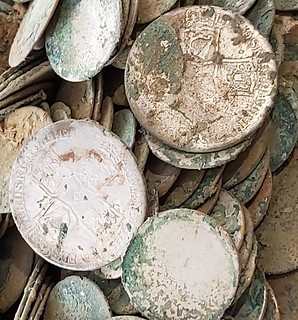 Although the stash remained unfound for two centuries, the police still had enough evidence to prosecute him and he was hanged at Stafford Gaol in 1801.
Although the stash remained unfound for two centuries, the police still had enough evidence to prosecute him and he was hanged at Stafford Gaol in 1801.
Mr McGimpsey, who only took up metal detecting during the first lockdown along with his four brothers, found the coins buried 10ins down.
The 332 half crowns, shillings and sixpences had the bust of King William III on one side and King George II on the reverse.
The hoard appears to have been wrapped in old bank notes, as a tiny fragment of paper was found which has been sent for analysis.
The previous record haul of forged coins is 92, which is now in the British Museum.
Julian Evan-Hart, editor of Treasure Hunting magazine, said it was an 'amazing' discovery which had more 'historical than monetary value'.
He said: "It is one of those classic metal detecting discoveries and you do wonder if there are other deposits still there which were buried in haste.
To read the complete article, see:
Britain's biggest ever hoard of forged coins found in Staffordshire field
(https://www.staffordshire-live.co.uk/news/local-news/britains-biggest-ever-hoard-forged-6404269)
THE BOOK BAZARRE
BATTLEFIELD ACQUIRES SOLDIER DOG TAG
The Washington Post published an article earlier this month about a battlefield museum's acquisition of a Union soldier's dog tag. -Editor
Private Samuel M. Weigel had already seen extensive combat by the time his veteran Union regiment reached the battlefield near Maryland's Monocacy River in July 1864.
Twenty-seven of his comrades in the 138th Pennsylvania Infantry had been killed at the Battle of the Wilderness near Fredericksburg, Va., that May, including five from his outfit, Company G.
Seven more from the regiment had been killed at the Battle of Cold Harbor outside Richmond in June.
He had no doubt seen the fate of friends who had fallen, with nothing to identify their bodies for return to their families. So on July 9, when he was seriously wounded at the Battle of Monocacy, near Frederick, Md., he was probably wearing a metal disk bearing his name, regiment and hometown.
This week, the National Park Service announced that the Monocacy National Battlefield Foundation has donated what appears to be the identification disk Weigel was probably wearing that day.
It is amazing that after 157 years, this ID disk is returning to the battlefield,
Andrew Banasik, superintendent of Monocacy National Battlefield, said in a statement. This small piece of metal is a tangible reminder of the price paid by so many to save Washington.
Civil War ID badges that survive are rare, the Park Service said. There were no government-issued military dog tags
during the war. And soldiers were terrified that if they were killed, in the chaos of battle their bodies would never be identified.
So a man might write his name on a piece of paper and pin it to his uniform before going into combat. He might stencil his name on his clothing. Or he might buy his own ID badge.
Jana Friesen McCabe, chief of resource education and visitor services at the battlefield, said that Weigel's disk was obtained for $1,700 from a reputable artifacts dealer on eBay and that the battlefield received it in October.
It is probably made of a copper alloy and was premade with one side blank, where the soldier's details could be stamped. That side bears Weigel's name, regiment, company and hometown, Bendersville, Pa.
The other side has a shield with a stars-and-stripes design and the phrase Against Rebellion 1861.
They were mass-manufactured
in 1861, McCabe said. The ‘1861' isn't a reflection of when he purchased it. It's more the start of the war and the production of those disks.
Weigel's might have been purchased from one of the traveling vendors, or sutlers,
who followed the armies. The vendor may have etched it for him, she said.
The battlefield has another ID badge that bears the name and details of another soldier from Company G — Sgt. Nicholas G. Wilson, who was also wounded in the battle. His badge is made of silver and in the shape of a shield.
To read the complete article, see:
Civil War battlefield museum gets rare Union soldier's ID tag
(https://www.washingtonpost.com/history/2021/12/17/civil-war-id-dog-tag/)
EURO BANKNOTE REDESIGN COULD REVIVE RIVALRIES
Articles on the impending redesign of Euro banknotes didn't make the cut for earlier issues, but here's a good new article on the political minefield of Euro banknote design. -Editor
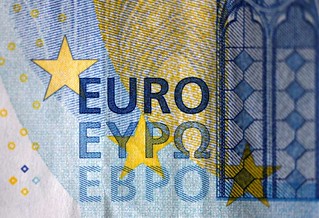 Twenty years after arriving in Europeans' wallets, euro banknotes will get a new look with help from the public, a process officials hope will make citizens feel closer to the single currency.
Twenty years after arriving in Europeans' wallets, euro banknotes will get a new look with help from the public, a process officials hope will make citizens feel closer to the single currency.
But the Austrian artist behind the original banknotes fears the redesign could spark national rivalries, something he painstakingly tried to avoid with neutral illustrations the first time around.
Now retired, Robert Kalina was working as a graphic designer for the Austrian National Bank when he won a competition in 1996 to create the artwork for the first-ever euro notes.
Kalina's designs were initially printed on 14.5 billion banknotes in denominations ranging from five to 500 euros.
Euro coins, which are minted by euro members, have a shared image on one side and a country-specific one the other. Ireland for instance opted for a harp, France for a tree.
But euro banknotes are issued by the European Central Bank, and their designs had to be identical across the euro region and avoid "national bias".
The challenge for Kalina was coming up with illustrations all Europeans could identify with, without stirring nationalist sentiments or appearing to favour one eurozone nation over another.
"Portraits might have been allowed, but only if the faces were anonymous. I excluded that option right away," Kalina said.
He decided to focus on architecture.
Drawing on inspiration from existing buildings, Kalina simplified and reworked their depictions with the help of engineering experts, to ensure the structures "were no longer recognisable" but still believable.
His bridge designs, showcasing different historical styles in Europe, symbolise the connection between eurozone citizens, "but also between the European Union and the rest of the world".
The windows and doorways on the other side of the notes stand for "openness and a vision of the future".
Despite the numerous crises that have rocked the currency since its birth, Kalina says the ideals he sought to portray are "still valid".
The ECB will rely on a 19-person panel of experts for the banknote design—one from each euro nation—and consult the public along the way.
"The question is whether people have come far enough to accept, for example, famous people being represented", even if they are linked to a particular country, Kalina said.
"Might it perhaps cause jealousy?" he asked, recalling heated debates on the issue in the 1990s.
The world of music might be a good place to look for inspiration for the next generation of notes, Kalina mused, since "great composers like Beethoven or Mozart can't be reduced to a single country".
To read the complete article, see:
Euro banknote artist fears redesign could revive rivalries
(https://phys.org/news/2021-12-euro-banknote-artist-redesign-revive.html)
SALVATION ARMY'S $1,000 BILL MYSTERY
Rich Bottles Jr. writes:
"Every year, the local news stations here in north central West Virginia run a story about a "mystery donor" who places a thousand dollar bill into one of the organization's red kettles... The only problem is, it's the same bill year after year."
Rich passed along this article from The Morgantown News. Thanks. -Editor
Sheldon Greenland, commanding officer of the Salvation Army of Monongalia, Marion, and Preston counties, spent his Christmas weekend off the computer and without his phone in hand. He did not realize there were questions about the annual donation of a $1,000 bill the Salvation Army has received every year since 1978.
Greenland, who has been in charge of the local organization since 2018, called WV News within 15 minutes of an article going online Tuesday morning showing that the $1,000 bill donated last week has the same serial number and unique markings as last year's donation.
Whenever we get the donation, we deposit the money into the bank, and we surmise that the anonymous donor has an arrangement to retrieve or repurchase the same or similar note each year from the bank,
Greenland said. And that's all the information we have. We have no idea who it is.
A WV News review of the bills in photos from 2020 and 2021 shows each bill has the same serial number and is from District 4. Each bill is creased in the same places, and there also appeared to be small marks — perhaps ink marks — on the upper right and upper left corners of the bills.
A reader first brought the matter to the attention of WV News.
The $1,000 donation is real and authentic,
Greenland said. And, it's a tradition we hope to continue for years to come into the future.
Greenland said nobody had ever mentioned this to him before, and he had never noticed it was the same $1,000 bill. Coverage from WBOY-TV in 2016 shows the $1,000 bill from five years ago has the same serial number as well.
I never even noticed that the serial numbers were the same, that it was the same bill — you guys brought it to my attention,
Greenland said.
Hmmmm... -Editor
To read the complete article, see:
UPDATE: Salvation Army rep addresses $1,000 bill donation questions; same bill has appeared over multiple years in Morgantown (West Virginia)
(https://www.wvnews.com/morgantownnews/news/1-000-bill-donated-to-salvation-army-in-morgantown-west-virginia-appears-to-be-same/article_569c0fe4-67f0-11ec-8ae3-5b80b09b7fbe.html)
LOST CLIPPER GOLD-BACKED BANKNOTES THEORY
Does an old aviation mystery have a connection to gold-backed banknotes? A group of Virginia adventurers thinks so. -Editor
During his research, he came across a non-fiction book by author Charles Hill titled, Fix on the Rising Sun: The Clipper Hi-Jacking of 1938.
I thought it was an amazing story that I had never heard before,
Noffsinger said. I started going down a rabbit hole.
Almost immediately, Noffsinger changed the focus of his thesis to explore what turned out to be a mystery stretching back to before World War II — the loss of the Pan Am Hawaii Clipper
over the Pacific Ocean, with 15 souls on board.
Here is the basic story of the Lost Clipper and as well as the theory posited by Noffsinger, Hill and others.
The Hawaii Clipper was a Martin M-130 flying boat, meaning the plane could land on water. It was part of the fleet of Pan American Airways, generally known as Pan Am and, at the time, the largest international air carrier in the world.
In July 1938, the Hawaii Clipper began Trip 229, a regularly scheduled 60-hour flight from San Francisco to Manila in the Philippines. It island-hopped along the way, stopping at Pearl Harbor in Hawaii, then Midway, Wake Island and Guam.
At 11:39 a.m. local time on July 28, 1938, the Hawaii Clipper took off from Guam for the final leg to Manila. Three hours and 27 minutes later, the plane lost contact with radio operators. It disappeared — somewhere over the vast deep blue waters of the Pacific — with six passengers and nine crew members on board and was never heard from again.
Based on more than two decades of research, Guy Noffsinger thinks he knows what happened to the missing plane — and believe it or not, it ties to the famous mystery of Amelia Earhart, who disappeared almost exactly a year earlier, in July 1937.
Noffsinger and others believe that at least some of the passengers and crew on the Hawaii Clipper were working for the U.S. government — that they had been told they were on a secret mission to transport $3 million in gold-backed banknotes to organized criminals within the Japanese Navy who were allegedly holding Earhart ransom.
Only it was a ruse, and the Japanese were actually after the new, long-distance engines on the Hawaii Clipper. They feared their own airplanes were less advanced and the new high-tech engines on the Clipper would give the United States an advantage in the run-up to World War II, which was already brewing.
The theory goes that two Japanese hijackers disguised as mechanics crept on board in Guam and hid in a cargo hold. This is based on FBI interviews at the time with Marine sentries who said they gave two mechanics access to the plane in the overnight hours. Once the plane was over the ocean, the Japanese agents took over the plane, forced it to land and took the passengers and crew prisoner.
Far-fetched of course, but no more off course than your typical conspiracy theory. The beauty of these theories is that there remains the slimmest chance that it might be true, and no one can prove otherwise. But who knows, perhaps this crew will at least find some evidence of the fate of the Lost Clipper. -Editor
To read the complete article, see:
Group of Loudoun County adventurers hopes to solve enduring aviation mystery
(https://www.insidenova.com/headlines/group-of-loudoun-county-adventurers-hopes-to-solve-enduring-aviation-mystery/article_1097cccc-6a61-11ec-a903-3b173900aff0.html)
LOOSE CHANGE: JANUARY 2, 2022
Here are some additional items in the media this week that may be of interest. -Editor
The second Lee statue time capsule has now been found. More numismatic items are mentioned but I haven't seen any published details yet. -Editor
Conservation experts in Virginia's capital pulled books, money, ammunition, documents and other artifacts Tuesday from a long-sought-after time capsule found in the remnants of a pedestal that once held a statue of Confederate Gen. Robert E. Lee.
Over the course of about two hours, the team sliced open the 36-pound copper box and meticulously pried apart and documented the damp contents. The box had been tucked in a foundation cornerstone of the massive — and now mostly deconstructed — Richmond monument since 1887.
Along with several waterlogged books, pamphlets and newspapers, the box contained an envelope of Confederate money, which conservators carefully separated, and two carved artifacts — a Masonic symbol and a Confederate flag said to have be made from the tree that grew over Gen. Stonewall Jackson's original grave.
Conservators also pulled buttons, coins and Minié balls, a type of bullet used in the Civil War, from the box. A bomb squad had checked the capsule Monday, partly to make sure there was no live ammunition inside.
To read the complete articles, see:
Experts pull documents, money from Lee statue time capsule
(https://news.yahoo.com/apparent-time-capsule-found-lee-162833602.html)
Confederate pride and the Chamber of Commerce: Richmond's Lee statue finally gives up its time capsule secrets
(https://www.washingtonpost.com/dc-md-va/2021/12/28/lee-statue-time-capsule-richmond/)
To read the earlier E-Sylum article, see:
COIN FOUND IN LEE STATUE TIME CAPSULE
(https://www.coinbooks.org/v24/esylum_v24n52a12.html)
This CoinWeek article by Doug Winter came out in November, but I came across it this week and thought readers would find it useful. Great image! How did they DO that? -Editor
As a dealer who works with collectors who range in experience from total beginners to full-on experts, I have a fairly good idea of what separates the masters from the wannabes. Experience, obviously, is part of the equation; but some of the best collectors I have ever seen are fairly new to the game and their skill is largely intuitive. Here are some suggestions and observations I'd like to share with you that might just make you a better collector.
Become A Student Of Your Series
The coin collectors who impress me the most are the ones who have become specialized in a certain series and who have studied it to the point that they are as knowledgeable about it as possible. This study can take many forms. Some coin collectors are interested in the history of the coins they collect, while others are more interested in the rarity and availability of coins. A coin collector might select a series to specialize in where there is little written and become the author of a book or a web-based guide. My take on studying a series is that for every hour you put into this, your reward is many times the effort.
To read the complete article, see:
10 Ways to Become a Better Coin Collector
(https://coinweek.com/editors-choice/10-ways-to-become-a-better-coin-collector/)
The ‘In God We Trust' motto on coins and money continues to attract the attention of interest groups. -Editor
City vehicles in Chesapeake, Virginia, will soon be getting religion.
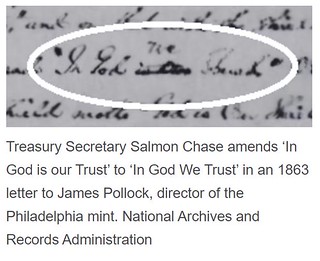 At a meeting on July 13, 2021, city councilors unanimously voted in favor of a proposal that would see the official motto of the U.S.,
At a meeting on July 13, 2021, city councilors unanimously voted in favor of a proposal that would see the official motto of the U.S., In God We Trust,
emblazoned on every city-owned car and truck, at an estimated cost to taxpayers of US$87,000.
Christian nationalists played a key role in getting In God We Trust
put on coins during the Civil War and ever since have attempted to use the motto as proof
that the United States is a Christian nation.
To read the complete article, see:
How ‘In God We Trust' bills are helping advance a Christian nationalist agenda
(https://theconversation.com/how-in-god-we-trust-bills-are-helping-advance-a-christian-nationalist-agenda-164143)

